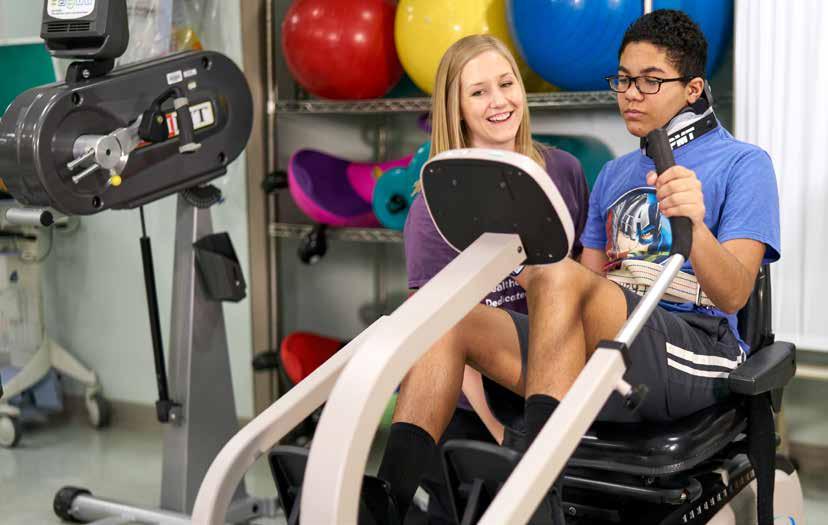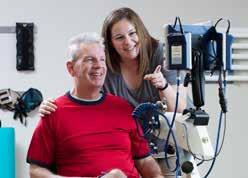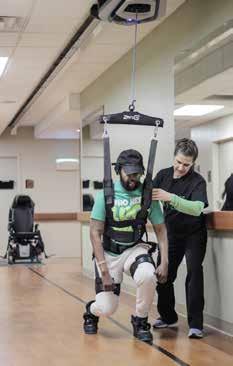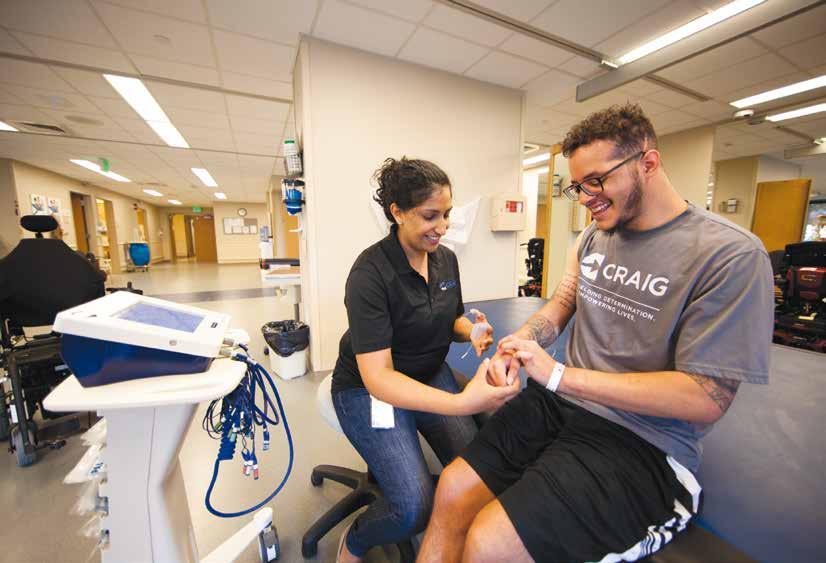BRAIN INJURY professional
Brain Injury and Violence: Moving Past Closed Doors

vol. 19 issue 3



SAVE THE DATE FOR FUTURE CONFERENCES OF THE INTERNATIONAL PAEDIATRIC BRAIN INJURY SOCIETY 2024 Glasgow 2026 Calgary Stay up-to-date on all IPBIS events: www.ipbis.org
8
Intimate Partner Violence and Brain injury: A Selective Overview

Eve Valera, PhD
10
Intersections of Psychological Health and Brain Injury in the Context of Intimate Partner Violence
Katherine M. Iverson, PhD • Kimberly B. Werner, PhD
Rachel Sayko Adams, PhD, MPH
14
• Tara E. Galovski, PhD
Assessment of IPV Related Brain Injury: What Do We Know and Where Do We Go?

Catherine B. Fortier, PhD • Sahra Kim, PsyD Alexandra Kenna, PhD
18
Multicultural Considerations of Violence and Brain Injury
Eva Fontaine, MA • Bryanna Fox, PhD • Joan A. Reid, PhD
22
Employment, Accommodation, and Planning after Violence and Brain Injury
Christina Dillahunt- Aspillaga, PhD • Stuart Rumrill, MS, CRC
DJ Hendricks, Ed • Brenda Eagan-Johnson, EdD, CRIST
Tammy Jorgensen Smith, PhD, CRC • Phillip Rumrill, PhD, CRC
26
Empowerment-based Advocacy and IPV-related Brain Injury Service Delivery Integration: CARE and The Abused & Brain Injured Toolkit

Julianna M. Nemeth, PhD, MA
Rachel Ramirez, MSW, RAAS
• Halina (Lin) Haag, MSW, RSW
NORTH AMERICAN BRAIN INJURY SOCIETY
CHAIRMAN Mariusz Ziejewski, PhD
VICE CHAIR Debra Braunling-McMorrow, PhD
IMMEDIATE PAST CHAIR Ronald C. Savage, EdD
TREASURER Bruce H. Stern, Esq.
SECRETARY Brian Greenwald, MD
FAMILY LIAISON Skye MacQueen
EXECUTIVE DIRECTOR/ADMINISTRATION Margaret J. Roberts
EXECUTIVE DIRECTOR/OPERATIONS J. Charles Haynes, JD
MARKETING MANAGER Megan Bell-Johnston
BRAIN INJURY PROFESSIONAL
PUBLISHER J. Charles Haynes, JD
CO-EDITOR IN CHIEF Beth Slomine, PhD - USA
CO-EDITOR IN CHIEF Nathan Zasler, MD - USA
ASSOCIATE EDITOR Juan Arango-Lasprilla, PhD – Spain
TECHNOLOGY EDITOR Stephen K. Trapp, PhD - USA
EDITOR EMERITUS Debra Braunling-McMorrow, PhD - USA
EDITOR EMERITUS Ronald C. Savage, EdD - USA
DESIGN AND LAYOUT Kristin Odom
ADVERTISING SALES Megan Bell-Johnston
EDITORIAL ADVISORY BOARD
Nada Andelic, MD - Norway
Philippe Azouvi, MD, PhD - France
Mark Bayley, MD - Canada
Lucia Braga, PhD - Brazil
Ross Bullock, MD, PhD - USA
Fofi Constantinidou, PhD, CCC-SLP, CBIS - USA
Gordana Devecerski, MD, PhD - Serbia
Sung Ho Jang, MD - Republic of Korea
Cindy Ivanhoe, MD - USA
Inga Koerte, MD, PhD - USA
Brad Kurowski, MD, MS - USA
Jianan Li, MD, PhD - China
Christine MacDonell, FACRM - USA
Calixto Machado, MD, PhD - Cuba
Barbara O’Connell, OTR, MBA - Ireland

Lisandro Olmos, MD - Argentina
Caroline Schnakers, PhD - USA
Lynne Turner-Stokes, MD - England
Olli Tenovuo, MD, PhD - Finland
Asha Vas, PhD, OTR - USA
Walter Videtta, MD – Argentina
Thomas Watanabe, MD – USA
Alan Weintraub, MD - USA
Sabahat Wasti, MD - Abu Dhabi, UAE
Gavin Williams, PhD, FACP - Australia
Hal Wortzel, MD - USA
Mariusz Ziejewski, PhD - USA
EDITORIAL INQUIRIES
Managing Editor
Brain Injury Professional
PO Box 131401, Houston, TX 77219-1401
Tel 713.526.6900 Email: mbell@hdipub.com
Website: www.nabis.org
ADVERTISING INQUIRIES
Megan Bell-Johnston
Brain Injury Professional
HDI Publishers
PO Box 131401, Houston, TX 77219-1401
Tel 713.526.6900 Email: mbell@internationalbrain.org
NATIONAL OFFICE
North American Brain Injury Society

PO Box 1804, Alexandria, VA 22313
Tel 703.960.6500 / Fax 703.960.6603
Website: www.nabis.org
ISSN 2375-5210
Brain Injury Professional is a quarterly publication published jointly by the North American Brain Injury Society and HDI Publishers. © 2023 NABIS/HDI Publishers. All rights reserved. No part of this publication may be reproduced in whole or in part in any way without the written permission from the publisher. For reprint requests, please contact, Managing Editor, Brain Injury Professional, PO Box 131401, Houston, TX 77219-1400, Tel 713.526.6900, Fax 713.526.7787, e-mail mbell@hdipub.com.
departments features Brain Injury Professional is a membership benefit of the North American Brain Injury Society and the International Brain Injury Association 5 Editor in Chief Message 7 Guest Editor’s Message 28 Expert Interview 30 Technology Article BRAIN INJURY professional 3
vol. 19 issue 3 professional
BRAIN INJURY



SAVE THE DATE! THE INTERNATIONAL BRAIN INJURY ASSOCIATION PRESENTS THE 14 TH WORLD CONGRESS ON BRAIN INJURY MARCH 3-6 2021 THE CONVENTION CENTRE DUBLIN DUBLIN, IRELAND WWW.INTERNATIONALBRAIN.ORG REGISTER NOW FOR IBIA2023 WWW.BRAININJURYCONGRESS.ORG
from the editor in chief
As Co-Editor-in-Chief, I am very pleased the share with you this issue of Brain Injury Professional that focuses on brain injury resulting from violence, with a focus on intimate partner violence (IPV). This is an incredibly important and understudied topic, and I was thrilled when Drs. Kathrine Iverson and Christina Dillahunt-Aspillaga approached me about editing an issue focusing on IPV-related brain injury.
Drs. Iverson and Dillahunt-Aspillaga are expert clinicians and researchers in brain injury and steeped in knowledge about brain injury that occurs in the context of IPV. Dr. Iverson is a clinical psychologist whose work focuses on the intersections between mental health and IPV. Dr. Dillahunt-Aspillaga is a doctoral-trained rehabilitation counselor and life care planner with expertise in brain injury and employment. In this issue, these guest editors assembled a series of articles that provide readers with a up to date overview of the extant literature examining brain injury in the context of IPV.
The feature article, entitled “Intimate Partner Violence and brain Injury: A Selective Overview,” was written by Dr. Eva Valera. In this article, Valera provides an overview of outcomes associated with IPVrelated BI and highlight the various mechanisms of injury, including not only traumatic brain injury, but repetitive traumatic brain injury, as well as hypoxic-ischemic injury associated with strangulation. Valera also points out that IPV is a global public health concern that is often not identified or reported.

Other articles expand on specific issues and provide practical advice for providers. Iverson, Werner, Adams, and Galovsk describe the comorbid mental health concerns that are commonly associated with brain injury in the context of IPV, including depression, PTSD, and substance use. The article by Fortier, Kim and Kenna provides a two-pronged approach to screening and assessment to identify and evaluate those with possible or suspected IPV-related brain injury more accurately. Fontain, Fox, and Reid discuss the impact of brain injury associated with violence in the context of environmental stressors and within under-represented and marginalized groups. Nine practice related services and legal interventions, that are unique to survivors of IPV, are outlined by Dillahunt-Aspillaga, Rumrill, Hendricks, Eagan-Johnson, Smith, and Rumrill. Additionally, two resources available to support survivors of IPV-related brain injury are described in the article by Nemeth, Haag, and Ramirez. The issue also includes an expert interview with Katherine Price Snedaker, the executive director and founder of Pink Concussions. Lastly, our technology editor, Dr. Stephen Trapp, provides a brief overview about an educational website developed to provide general information about the topic of IPV and brain injury for those experiencing or at risk for IPV.
Finally, mark your calendars the 2023 International Brain Injury Association (IBIA) World Congress on Brain Injury which will be held in Dublin Ireland from March 29th to April 1, 2023. The International Brain Injury Association (IBIA) World Congress is the largest gathering of international professionals working in the field of brain injury. For more information, go to www.braininjurycongress.org.

Editor Bio
Beth S. Slomine, PhD, ABPP, is co-director of the Center for Brain Injury Recovery and director of neuropsychology training and neuropsychological rehabilitation services at Kennedy Krieger Institute. She is an Associate Professor of Psychiatry & Behavioral Sciences and Physical Medicine & Rehabilitation at Johns Hopkins University School of Medicine. She is a licensed psychologist, board certified clinical neuropsychologist, and board certified subspecialist in pediatric neuropsychology. Research interests include developing neurobehavioral assessment tools and understanding factors influencing outcome following pediatric neurological injury. Dr. Slomine has authored >70 peer-reviewed manuscripts, numerous book chapters, and co-edited a textbook entitled Cognitive Rehabilitation for Pediatric Neurological Conditions.
BRAIN INJURY professional 5
Beth S. Slomine, PhD, ABPP
Raising the bar for inpatient and day rehabilitation services
Children’s Healthcare of Atlanta is Commission on Accreditation of Rehabilitation Facilities (CARF)-accredited for pediatric rehabilitation services.


We offer:
• An expansive Inpatient Rehabilitation Program
A spinal cord system of care, brain injury and pediatric specialty programs that have received CARF specialty recognition
A team of brain injury board-certified pediatric physiatrists
– Comprehensive care for young patients from birth to age 21
– Therapy seven days a week
– 28 private patient rooms
• A Day Rehabilitation Program to assist patients during recovery
• Technology-assisted therapy through our Center for Advanced Technology and Robotic Rehabilitation
• A full-service hospital with emergency services
Learn more or make a referral:
404-785-2274
choa.org/rehab
© 2018 Children’s Healthcare of Atlanta Inc. All rights reserved. REH 11772.ck.12/2018 Children’s Healthcare of Atlanta has: Three hospitals • 27 neighborhood locations • 1 million+ patient visits per year
–
–
Katherine Iverson, PhD

guest editors
Brain Injury and Violence: Moving Past Closed Doors
It is a privilege to serve as the guest editors for this issue of Brain Injury Professional that provides an overview and update on the existing body of evidence of brain injury consequential of violence, particularly intimate partner violence (IPV). Despite growing data, research is scant on recognition and interventions for those who sustain brain injuries following violence. Brain injury in the context of IPV and other forms of interpersonal violence differs from other more commonly studied brain injuries (e.g., falls, motor vehicle accidents, sports- and military-related injuries). Multicultural considerations of violence related brain injuries may be similar or differ across cultural, social, and racial/ethnic sub-groups. A brain injury caused by violence may be overlooked and unrecognized and lead to inaccurate diagnosis and treatment planning, hindering access to timely and appropriate care, resources, supports and services. In particular, individuals who experience IPV often do not seek medical care following head injuries. Moreover, most violence related injuries are screened in community settings or emergency rooms where there is limited time, appropriately trained staff, or resources required to complete comprehensive screenings and assessments.
Efforts to increase screening for brain injury as a result of violence across care contexts are needed to identify those at risk, especially among women experiencing IPV. There is also a need for greater diagnostic accuracy, particularly in the context of complex clinical presentations. Psychological health problems, especially posttraumatic stress disorder, depression, and substance use disorders, may stem from both violence and brain injury. Treatment of ongoing effects of brain injury and comorbid psychological health concerns are potentially lifesaving as these experiences may have deleterious effects on safety. Violence related traumatic events can result in significant impairment in social, occupational, or academic functioning. Current resources available to support survivors of violence related brain injury include
1) CARE, an evidence-based and brain injury-informed approach to advocacy, and
2) the Abused & Brain Injured Toolkit, an online educational resource for direct service providers across sectors and women survivors.
from the Editor Bios
Christina Dillahunt-Aspillaga, PhD, received her PhD in Rehabilitation Science from the University of Florida. She is a Certified Rehabilitation Counselor (CRC), a Certified Vocational Evaluator (CVE), a Certified Life Care Planner (CLCP), and a Certified Brain Injury Specialist Trainer (CBIST). She is an ACRM Fellow, and she is a Diplomate in the College of Vocational Rehabilitation Professionals. She is employed as a tenured Full Professor in the Department of Child and Family Studies, Rehabilitation and Mental Health Counseling program in the College of Behavioral and Community Sciences at the University of South Florida, Tampa. Her research interest areas include employment for persons with disabilities.
Katherine Iverson, PhD, is a clinical psychologist at the Women’s Health Sciences Division of the National Center for PTSD at the VA Boston Healthcare System and an Associate Professor of Psychiatry at Boston University. She has collaborated on several brain injury studies, including examinations of (a) gender differences in post-TBI psychosocial health outcomes among veterans, (b) TBI screening and evaluation in the Veterans Health Administration, and (c) treatment needs of women who experience intimate partner violence (IPV) and PTSD. Kate’s work focuses on the intersections between mental health and IPV, with an emphasis on screening and counseling interventions.

BRAIN INJURY professional 7
Christina Dillahunt-Aspillaga, PhD
Intimate partner violence (IPV) is a common experience for women.
IPV is any physical, sexual, and/or psychological violence perpetrated against a past or current intimate partner (e.g., girlfriend/boyfriend, husband/wife, dating or sexual partner). It is the leading cause of homicide for women globally and the most common form of violence against women.1 It has been estimated that approximately one in three women over age 15 experience physical or sexual IPV in their lifetime.2 Women who are rich, poor, old and young can become effectively “trapped” in partner violent relationships as a result of the partner’s coercive and controlling tactics (e.g., threats of murder, deportation and child abduction, and financial control). Although some groups of women are disproportionally affected by IPV (i.e., severity), this form of violence crosses ALL ages, races, ethnicities, sexual and gender identities, cultures, and socioeconomic levels. Men experience IPV too, but data are currently lacking on brain injury from IPV in men, so by necessity this article is focused on women.
IPV frequently causes brain injury.
IPV can result in acquired brain injuries (BI) either from external forces to the head (e.g., hitting the head with a fist or hard object, slamming the head against a hard object, wall or floor), or from hypoxic-ischemia via strangulation. Epidemiological data on the prevalence of IPV-related BI are scant, but a nationally representative study found that approximately 6.2 million women reported a loss of consciousness from the abuse of a partner.3 As loss of consciousness is only one of several criteria for diagnosing BI, the number of women sustaining IPV-related BI would be expected to be much higher (and is substantiated by other data presented below). By comparison, there are approximately 3.8 million women with a history of breast cancer in the U.S. including women undergoing current and having completed past treatment.4 So even without considering a majority of potential BIs, there are nearly twice as many women sustaining IPV-related BIs than suffering from cancer in the US. Yet the time, funding, research and resources devoted to breast cancer are far greater than that for IPV-related BI. A similar statement can also be made about the amount of time, funding, and resources that are devoted to understanding mostly male athletes and military servicemembers relative to women experiencing IPVrelated BI, despite evidence indicating IPV is a frequent cause of BI in women.
COVID-19 has increased rates and severity of IPV globally.
Historically, upticks in IPV have been observed with both natural disasters and economic crises.
Intimate Partner Violence and Brain injury: A Selective Overview
 Eve Valera, PhD
Eve Valera, PhD
After Hurricane Katrina physical violence towards women increased nearly two-fold in the surrounding Mississippi areas.5 After the Great Recession (2007-2009), unemployment and economic hardship were associated with abusive behavior towards women.6
Consistent with initial concerns, media reports around the globe have indicated spikes in rates of IPV and increases in the severity of violence including IPV-related femicide. In a recent study conducted in the United States,7 IPV-related injuries identified in radiological reports during COVID-19 were 1.8 times greater compared to the past 3 years, and the number of more severe or “deep” injuries was 1.1 per victim compared to 0.4 previously. Additionally, media reports in the United Kingdom indicated a doubling of femicide in the first few months of COVID-19 “lockdown”.8 For individuals experiencing IPV during the COVID-19 pandemic, the threat of violence is increased because of new economic uncertainties and hardships, and because of the unintended consequences of mitigation strategies aimed at curbing the pandemic. For example, women may be forced to “lockdown” with partners who use violence thus increasing exposure to violence, and/or women may isolate themselves from family or friends who may otherwise be able to assist them.
The likely increase on IPV-related BI is going largely unnoticed by the public.
Unfortunately, the increase in IPV-related BIs has received little attention both in the lay media and research-based journals.9,10 There was no mention of BI in a 45-page report11 discussing pandemics and increases in violence against women and children, and there are scant media reports highlighting BI as a concern for IPV survivors. One report described a woman who was badly beaten into unconsciousness and stabbed in the eye with a piece of glass; a BI was not listed as one of the injuries.12 These examples raise the possibility that while rates of IPV-related BIs are increasing they are still being overlooked by not only the media and research community, but also the medical community. Given the chronicity of the COVD-19 pandemic, women will likely remain at a heightened risk for IPV-related BI.
IPV-related BI is often repetitive and associated with cognitive, psychological, and neural connectivity outcomes.
Though limited, a growing literature links the number, recency and severity of IPV-related BIs to a range of negative outcomes. When assessed among women who experience IPV, the majority of BIs have been mild in severity, but Valera and colleagues13 found that 10% of their sample (that included only women who had
8 BRAIN INJURY professional
experienced at least one instance of physical IPV) sustained at least one moderate to severe BI and 3% sustained repetitive moderate to severe BIs from IPV. These percentages are much lower than the 74 and 51% respective figures for at least one or repetitive mild BIs reported in that same sample. These data underscore the importance of recognizing that although mild BIs are most common, more severe BIs also occur. Guided by this knowledge Valera and colleagues13 used a BI score based on number and recency of self-reported BIs and whether a woman had sustained a moderate to severe IPV-related BI, to examine cognitive and psychological outcomes. Higher BI scores were associated with lower learning and memory scores and poorer performance on a test of cognitive flexibility. The team confirmed that these associations were not merely the result of IPV severity or measures of psychological distress. Furthermore, higher BI scores were associated with higher levels of depression, worry, anxiety and posttraumatic stress symptoms.
More recently, Valera and colleagues used neuroimaging to examine associations between BI scores and both structural and functional neural connectivity.14,15 The team put women in a magnetic resonance imaging (MRI) scanner and had women simply lay there and stay awake. First, they used scans to measure the degree to which certain brain regions were communicating with one another to assess resting-state functional connectivity between the Salience and Default networks.14 Communication between these networks is important for efficient cognitive functioning. The team found that the greater the BI score a woman had, the less positively certain regions, namely the right anterior insula and posterior cingulate cortex/precuneus of these two networks, communicated with each other. More importantly, the less positively these two regions communicated with one another, the more poorly women tended to perform on a test of learning and memory. Later, Valera and colleagues examined the effects of repetitive mild BIs on structural connectivity by examining water diffusion in the axons of certain white matter brain regions that have been implicated in repetitive mild traumatic BIs.15 Akin to findings on repetitive BIs in football players, Valera and colleagues found an association between BI scores and water diffusion in two of the three regions examined, the posterior and superior corona radiata. In combination with the aforementioned frequency of IPV-related BIs among women in the United States, these collective findings demonstrating associations of the BI score with cognitive, psychological and neural connectivity data suggest that BIs from IPV are having a host of negative effects on the lives of millions of women in the United States alone.
Strangulation can result in IPV-related BI and is associated with poor cognitive and psychological outcomes.
Valera and colleagues recently examined the effects of strangulationrelated BIs independent of IPV-related traumatic BIs to understand the potentially unique contribution of strangulation-related acquired BIs to negative cognitive and psychological outcomes.16 They compared women who had and had not experienced an alteration in consciousness from being strangled while controlling for IPV-related BIs. Results indicated that, women who experienced alteration in consciousness demonstrated poorer working and long-term memory scores and higher levels of depression and posttraumatic stress disorder symptoms. As no other published studies have used neuropsychological measures to assess the cognitive impact of strangulation-related alterations in consciousness, these data represent a first step in understanding the outcomes of strangulation in women who have experienced IPV.
Immediate recognition and intervention for IPV-related BI is critically needed.
Here I have presented some of the data that has most directly linked IPV-related BI with a range of negative outcomes. Despite these and other data, there is little research and infrastructure to support recognition and intervention for IPV-related BI. Failure to recognize the occurrence of BIs in women who have experienced IPV can result in misunderstandings, misdiagnoses, and inadequate treatment.9 For example, law enforcement or medical personnel responding to IPV incidents may misattribute disorientation or confusion as intoxication rather than indications of a partner-inflicted BI if the right questions are not asked or considered. Rather than getting proper medical attention, such a misattribution could result in an arrest or dismissal of abuse allegations. The time has come to aggressively address this global public health issue.
References
1. Stöckl H, Devries K, Rotstein A, et al. The global prevalence of intimate partner homicide: A systematic review. Lancet. 2013;382(9895):859-865. doi:10.1016/S0140-6736(13)61030-2
2. Devries KM, Mak JYT, Garcia-Moreno C, et al. The global prevalence of intimate partner violence against women. Science (80- ). 2013;340(6140):1527-1528. doi:10.1126/science.1240937
3. Breiding MJ, Chen J, Black MC. Intimate Partner Violence in the United States — 2010.; 2014.
4. American Cancer Society. About Breast Cancer. American Cancer Society. Published 2021. Accessed December 14, 2021. http://www.cancer.org/cancer/breast-cancer/about/what-is-breast-cancer.html
5. Schumacher JA, Coffey SF, Norris FH, Tracy M, Clements K, Galea S. Intimate partner violence and Hurricane Katrina: Predictors and associated mental health outcomes. Violence Vict. 2010;25(5):588-603. doi:10.1891/0886-6708.25.5.588
6. Schneider D, Harknett K, McLanahan S. Intimate partner violence in the Great Recession. Demography. 2016;53(2):471-505. doi:10.1007/s13524-016-0462-1
7. Gosangi B, Park H, Thomas R, et al. Exacerbation of physical intimate partner violence during COVID-19 lockdown. Radiology. 2020;298(1):E38-E45. doi:10.1148/radiol.2020202866
8. Grierson J. Domestic abuse killings “more than double” amid Covid-19 lockdown. The Guardian. April 15, 2020. Accessed December 14, 2021. https://www.theguardian.com/society/2020/apr/15/domestic-abusekillings-more-than-double-amid-covid-19-lockdown
9. Valera EM. When pandemics clash: Gendered violence-related traumatic brain injuries in women since COVID-19. EClinicalMedicine. 2020;24:100423. doi:10.1016/j.eclinm.2020.100423
10. Saleem GT, Fitzpatrick JM, Haider MN, Valera EM. COVID-19-induced surge in the severity of gender-based violence might increase the risk for acquired brain injuries. SAGE Open Med. 2021;9. doi:10.1177/20503121211050197
11. Peterman A, Potts A, Donnell MO, et al. Pandemics and violence against women and children. Center for Global Development Working Paper, 528. Published 2020. Accessed December 14, 2021. https://www.cgdev. org/publication/pandemics-and-violence-against-women-and-children
12. Donovan L. A transport ban in Uganda means women are trapped at home with their abusers. CNN. Published May 15, 2020. Accessed December 14, 2021 https://edition.cnn.com/2020/05/15/africa/ugandadomestic-violence-as-equals-intl/index.html.
13. Valera EM, Berenbaum H. Brain injury in battered women. J Consult Clin Psychol. 2003;71(4):797-804. doi:10.1037/0022-006X.71.4.797
14. Valera E, Kucyi A. Brain injury in women experiencing intimate partner-violence: neural mechanistic evidence of an “invisible” trauma. Brain Imaging Behav. 2017;11(6):1664-1677. doi:10.1007/s11682-0169643-1
15. Valera EM, Cao A, Pasternak O, et al. White matter correlates of mild traumatic brain injuries in women subjected to intimate-partner violence: A preliminary study. J Neurotrauma. 2019;36(5):661-668. doi:10.1089/neu.2018.5734
16. Valera E.M., Daugherty J.C., Scott O. BH. Strangulation as an acquired brain injury in intimate-partner violence and its relationship to cognitive and psychological functioning: A preliminary study. J Head Trauma Rehabil. 2022;37(1):15-23.doi:10.1097/HTR.0000000000000755.
Eve Valera, PhD, Associate Professor in Psychiatry at Harvard Medical School and Research Scientist at Massachusetts General Hospital has worked in the domestic violence field for 25+ years using a range of methodologies to understand the neural, cognitive and psychological consequences of brain injuries from partner-violence, with her most recent focus being on transgender women. She regularly lectures internationally and has received national and international recognition (e.g., TV news, NYT Magazine, Forbes, CBC Canadian radio). She is the recipient of the prestigious Robert D. Voogt Founders Award, Rappaport Research Fellowship in Neurology, and PINK Concussions Domestic Violence Award.
BRAIN INJURY professional 9 BRAIN INJURY professional 9
Author Bio
Intersections of Psychological Health and Brain Injury in the Context of Intimate Partner Violence
Brain injuries, including traumatic brain injuries (TBI) and anoxic brain injuries (from strangulation), are among the most dangerous injuries faced by women subjected to intimate partner violence (IPV), as reviewed by Valera.1 Of course, brain injuries are not the only ‘invisible’ wounds of IPV. Not surprisingly, experiences of psychological, sexual, and physical violence are strongly associated with psychological health conditions. Effective treatment of brain injuries among women who experience IPV requires attention to posttraumatic stress disorder (PTSD) and common co-occurring psychological health conditions. In this article we (1) discuss research on brain injuries in the context of co-occurring PTSD, depression, and substance use among women who experience IPV and (2) highlight unique clinical considerations for treating psychological health conditions in the context of IPV and brain injury.
IPV-Related Brain Injury and Comorbid PTSD and Depression

Although IPV-related brain injuries have received sustained attention in recent years, three decades of research provide indisputable evidence that physical, sexual, and psychological forms of IPV can cause and exacerbate PTSD and other mental health conditions. PTSD and depression are among the most prevalent and debilitating consequences of IPV.2 Findings from healthcare and populationbased samples indicate that women who experience IPV are 2 to 3 times more likely than those without IPV to have a diagnosis of PTSD and/or depression.3-5
Women who experience both brain injuries and mental health problems stemming from IPV are likely to face particularly deleterious health effects. While each type of exposure alone is robustly associated with poorer health and functioning, together they may have a synergistic effect in contributing to an array of adverse health outcomes for individuals who experience IPV. Iverson
et al.6 examined the associations between IPV-related brain injury and PTSD symptomatology among 224 women with lifetime IPV, of whom 28% screened positive for IPV-related brain injury. Women with IPV-related brain injury with persistent neurological symptoms (e.g., ongoing memory problems, balance problems or dizziness, and headaches) were 6 times more likely than women without a history of IPV-related brain injury to have probable PTSD, adjusting for race, income, and past-year IPV experiences. An 18-month follow-up study of women from this same sample demonstrated that when controlling for the significant effects of baseline PTSD, those who experienced IPV-related TBI with persistent neurological symptoms at baseline reported significantly higher levels of depression, insomnia, and somatic symptoms 18-months later compared to women who experienced probable IPV-related brain injury without persistent neurological symptoms at baseline.7 These findings suggest that both the persistent neurological symptoms caused by IPV-related brain injury and PTSD are uniquely associated with worse psychological health over time.
Although PTSD is common among women who experience IPVrelated brain injuries, comprehensive research on both brain injuries and PTSD in IPV populations remains sparse. To help fill this gap, Galovski et al.8 recently conducted the most comprehensive assessment of PTSD and brain injury to date, which included clinician-administered interviews of trauma exposure, brain injuries, and psychological diagnoses (along with brain imaging and blood assays). This community sample of 51 women who experienced lifetime IPV and screened positive for PTSD reported high rates of trauma exposure across the lifespan, particularly interpersonal violence (e.g., 71% experienced childhood sexual abuse, 47% experienced childhood physical abuse, and 45% experienced adult sexual assault from a non-intimate partner). As for psychological health, 80% met diagnostic criteria for PTSD, 22% met criteria for major depression, and 18% met criteria for at least one substance use disorder.
10 BRAIN INJURY professional
Katherine M. Iverson, PhD • Kimberly B. Werner, PhD • Rachel Sayko Adams, PhD, MPH • Tara E. Galovski, PhD
events 2023
7. The U.S. Consumer Products Safety Commission found more than 750 deaths and 25,000 hospitalizations in its 10-year study of the dangers of portable electric generators. https://www.cpsc.gov/es/content/briefingpackage-on-the-proposed-rule-safety-standard-forportable-generators
8. For the current guidelines: http://wedocs.unep. org/bitstream/handle/20.500.11822/8676/Select_ pollutants_guidelines.pdf?sequence=2
Experience You Can Trust in Brain Injury Law

March:
29 – 1 – 14th World Congress on Brain Injury, March 29 – April 1, Dublin, Ireland at the Convention Centre Dublin. For more information, visit www.braininjurycongress.org.
9. In an April 2017 carbon monoxide poisoning at a hotel in Niles, Michigan, several first responders had to be hospitalized because they were not wearing masks while they treated severely poisoned children. In a recent Detroit poisoning, the first responders did not have carbon monoxide detectors and also might have been poisoned. CO was not determined to be the cause for 20 to 30 minutes.
10. http://www.corboydemetrio.com/news-121.html





April
Source: “This paper was presented at the Proceedings of the 1st Annual Conference on 11. Environmental Toxicology, sponsored by the SysteMed Corporation and held m Fairborn, Ohio on 9, 10th and 11 September 1970.“
20 – 23 – American Occupational Therapists Association INSPIRE 2023, April 20 – 23, Kansas City, Missour. For more information, visit www.aota.org.
ABOUT THE AUTHOR
May
10 – 12 – Canadian Association of Occupational Therapists Conference 2023, May 10 – 12, Saskatoon, SK. For more information, visit https://caot.ca/site/ prof-dev/pd/conference?nav=sidebar&ba nner=3.
June
Gordon Johnson is a leading attorney, advocate and author on brain injury. He is a 1979 cum laude graduate of the University of Wisconsin law school and a journalism grad from Northwestern University. He has authored some of the most read web pages in brain injury. He is the Past Chair of the Traumatic Brain Injury Litigation Group, American Association of Justice. He was appointed by Wisconsin’s Governor to the state’s sub-agency, the TBI Task Force from 2002 – 2005. He is also the author of two novels on brain injury, Crashing Minds and Concussion is Forever.
21 – 23 - Occupational Therapy Australia 30th National Conference & Exhibition, June 21 – 23, Cairns, Australia. For more information, visit https://www. otausevents.com.au/otaus2023/cairns.
September
16 – 17 - International Conference on Advancements in Trauma and Brain Injury Management, September 16 -17, Amsterdam, The Netherlands. For more information, visit https://waset.org/ advancements-in-trauma-and-brain-injurymanagement-conference-in-september2023-in-amsterdam.
October
30 – 2 - American Congress of Rehabilitation Medicine, October 30 –November 2, Atlanta, Georgia. For more information, visit www.acrm.org.
November
15 – 19 – American Academy of Physical Medicine and Rehabilitation Annual Assembly, November 15-19, 2023, New Orleans, Louisiana. For more information, visit www.aapmr.org.
With over 30 years of experience in the area of head and brain injuries, nationally recognized Stark & Stark attorney Bruce H. Stern devotes himself to obtaining the compensation his injured clients deserve and to providing them with personal guidance to coordinate and promote the healing process.
 H. Stern, Esq.
H. Stern, Esq.
BRAIN INJURY professional 11 BRAIN INJURY PROFESSIONAL 22
Bruce
bstern@stark-stark.com
www.StarkInjuryGroup.com www.BrainInjuryLawBlog.com 1-800-53-LEGAL Follow Us: 993 Lenox Drive, Lawrenceville, NJ 08648
We Put You First ...By improving the lives of individuals with a traumatic brain injur y or other neurological impairment through residential and/or outpatient therapies. 5666 Clymer Road • Quaker town PA 18951 215-538-3488 • SuccessRehab.com 4.875 x 4.875.qxp_front 11/1/17 12:02 Page 1
Subconcussive head injuries from IPV were common (77%) as were diagnoses of brain injury from various etiologies (53%), including IPV-related brain injuries (35%).8 These findings highlight the clinical complexity of this population, including psychological trauma and brain injuries from IPV and other etiologies. Given the harmful impacts of repetitive TBIs and subconcussive head injuries, women with IPV histories likely experience a higher burden of psychological trauma and head injuries than women without IPV.
TBI and Substance Use
The relationship between IPV and substance use is complex, with evidence of a positive bi-directional relationship.9 Substance use can have a facilitating role in IPV by precipitating or exacerbating violence.10 Moreover, substances can be used to self-medicate from the physical or psychological effects of IPV.11 A study of medical record data from nearly 9,000 women patients of the Veterans Health Administration found that women with past-year IPV were 2.5 to 3 times more likely to have alcohol and/or drug use disorders relative to women without past-year IPV.12 While more research is needed, one longitudinal study of women using the emergency department found that risk for IPV varied by type of substance used (e.g., women who reported using heroin, crack or cocaine were twice as likely to experience IPV, with even higher risk for physical injury compared to women without IPV).13
Research also demonstrates that TBI is associated with increased at-risk substance use following injury.14 Until recently, evidence has been the strongest for alcohol, with numerous studies indicating increased risk for binge drinking and development of alcohol-related disorders post-TBI.14 Additionally, individuals with TBI history are at increased risk for opioid use and its devastating consequences (e.g., overdose, dependence, suicidality), including increased potential for a cascade of vulnerabilities (e.g., pain) that increase the likelihood of opioid use advancing to opioid misuse.15
Thus, women who experience both IPV and TBI may be at particularly high risk for substance use problems, yet research on this specific population is lacking. Future research might consider if there is an increased risk for use of specific types of substances (e.g., opioids) and whether the risk is specific to brain injury that occurred during IPV (TBIs or anoxic brain injuries) versus from other etiologies (e.g., car accident).
Clinical Considerations
Providers delivering care related to brain injury must understand that many individuals who experience IPV live with undiagnosed psychological health conditions while simultaneously suffering from effects of brain injury. Early identification and appropriate treatment of the effects of brain injury and psychological distress are potentially lifesaving as experiences of brain injury and comorbid psychological health conditions may have synergistic effects on women’s health in ways that compromise safety in intimate relationships.
Symptoms of PTSD, depression, and at-risk substance use can reduce safety in relationships and make it even more difficult to end an abusive relationship.16-18 Negative cognitions and mood after IPV are key components of PTSD that may increase individuals’ likelihood of staying in violent relationships. Distorted cognitions about the cause of the abuse (e.g., “I must have done something to deserve it”) can lead to self-blame. High levels of PTSD and/or depression symptoms, combined with substance use to cope with
these symptoms and their effects, may hinder decision-making and actions necessary to achieve safety. IPV can also impede substance use treatment outcomes; one study found that women who reported current IPV at substance use treatment admission had 25% decreased odds of treatment completion compared to women without IPV.19
Effective treatment of psychological health conditions may reduce risk for future IPV.16 Evidence-based psychotherapies are an important piece of recovery from IPV and are often indicated for women who experience IPV-related brain injury. Galovski and colleagues20 reported that head injuries endured during interpersonal traumas (including IPV) do not negatively impact recovery during cognitive-behavioral therapy for PTSD. Additional research should determine whether such findings generalize to diagnosed brain injuries as a small pilot study found that women with IPV experiences, PTSD, and TBI history improved during Cognitive Processing Therapy but they achieved smaller treatment gains than their counterparts without TBI.21 A longer therapy dose and/or other adaptations to treatment (i.e., cognitive rehabilitation) may optimize gains in the context of brain injury. Integrated services that address brain injury, psychological health, and IPV-related needs are urgently needed. Currently, these services are often siloed and inaccessible to those who need them most.
In conclusion, women who experience IPV may get trapped in a cycle of abuse, with relationship violence leading to brain injuries and psychological distress in the form of PTSD, depression, and/or at-risk substance use, followed by future victimization. Brain injury professionals may be well-positioned to identify and interrupt or prevent this cycle of violence. Although responsibility for IPV always rests with the perpetrators of violence, we must do what we can to identify and intervene on risk factors, particularly those that women can influence, to promote well-being and safety.
References
1. Valera, E. Violence and brain injury: A brief overview. Brain Inj. 2023.
2. Iverson, K.M. Practical implications of research on intimate partner violence against women. PTSD Research Quarterly 2020, 31, 1-4.
3. Bonomi, A.E.; Anderson, M.L.; Reid, R.J.; Rivara, F.P.; Carrell, D.; Thompson, R.S. Medical and psychosocial diagnoses in women with a history of intimate partner violence. Arch. Intern. Med. 2009, 169, 1692-1697, doi:10.1001/archinternmed.2009.292.
4. Iverson, K.M.; Dick, A.; McLaughlin, K.A.; Smith, B.N.; Bell, M.E.; Gerber, M.R.; Cook, N.; Mitchell, K.S. Exposure to interpersonal violence and its associations with psychiatric morbidity in a US national sample: A gender comparison. Psychol. Violence 2013, 3, 273-287, doi:10.1037/a0030956.
5. Iverson, K.M.; Vogt, D.; Dichter, M.E.; Carpenter, S.L.; Kimerling, R.; Street, A.E.; Gerber, M.R. Intimate partner violence and current mental health needs among female veterans. J. Am. Board Fam. Med. 2015, 28, 772-776, doi:10.3122/jabfm.2015.06.150154.
6. Iverson, K.M.; Dardis, C.M.; Pogoda, T.K. Traumatic brain injury and PTSD symptoms as a consequence of intimate partner violence. Compr. Psychiatry 2017, 74, 80-87, doi:10.1016/j.comppsych.2017.01.007.
7. Iverson, K.M.; Dardis, C.M.; Grillo, A.R.; Galovski, T.E.; Pogoda, T.K. Associations between traumatic brain injury from intimate partner violence and future psychosocial health risks in women. Compr. Psychiatry 2019, 92, 13-21, doi:10.1016/j.comppsych.2019.05.001.
8. Galovski, T.E.; Werner, K.B.; Iverson, K.M.; Kaplan, S.; Fortier, C.B.; Fonda, J.R.; Currao, A.; Salat, D.; McGlinchey, R.E. A multi-method approach to a comprehensive examination of the psychiatric and neurological consequences of intimate partner violence in women: a methodology protocol. Front. Psychiatry 2021, 12, 108, doi:10.3389/fpsyt.2021.569335.
9. Macy, R.J.; Goodbourn, M. Promoting successful collaborations between domestic violence and substance abuse treatment service sectors: a review of the literature. Trauma Violence Abuse 2012, 13, 234-251, doi:10.1177/1524838012455874.
10. Easton, C.J. The role of substance abuse in intimate partner violence. Psychiatr. Times 2006, 23, 25-25.
11. Stone, R.; Rothman, E.F. Opioid use and intimate partner violence: A systematic review. Curr. Epidemiol. Rep. 2019, 6, 215-230, doi:10.1007/s40471-019-00197-2.
12. Dichter, M.E.; Sorrentino, A.; Bellamy, S.; Medvedeva, E.; Roberts, C.B.; Iverson, K.M. Disproportionate mental health burden associated with past-year intimate partner violence among women receiving care in the Veterans Health Administration. J. Trauma. Stress 2017, 30, 555-563, doi:10.1002/jts.22241.
13. Gilbert, L.; El-Bassel, N.; Chang, M.; Wu, E.; Roy, L. Substance use and partner violence among urban women seeking emergency care. Psychol. Addict. Behav. 2012, 26, 226-235, doi:10.1037/a0025869.
14. Corrigan, J.; Adams, R.; Dams, O.C.K. At-risk substance use and substance use disorders, 3rd ed.; Springer Publishing Company LLC: 2021.
15. Adams, R.S. Traumatic Brain Injury and Opioid Use: Additional Evidence Supporting the “Perfect Storm” of Cascading Vulnerabilities. J. Head Trauma Rehabil. 2021, 36, 303-309, doi:10.1097/ HTR.0000000000000730.
12 BRAIN INJURY professional
16. Iverson, K.M.; Gradus, J.L.; Resick, P.A.; Suvak, M.K.; Smith, K.F.; Monson, C.M. Cognitive–behavioral therapy for PTSD and depression symptoms reduces risk for future intimate partner violence among interpersonal trauma survivors. J. Consult. Clin. Psychol. 2011, 79, 193-202, doi:10.1037/a0022512.
17. Mahoney, C.T.; Iverson, K.M. The roles of alcohol use severity and posttraumatic stress disorder symptoms as risk factors for women's intimate partner violence experiences. J. Women's Health 2020, 29, 827-836, doi:10.1089/jwh.2019.7944.
18. Perez, S.; Johnson, D.M. PTSD compromises battered women's future safety. J. Interpers. Violence 2008, 23, 635-651, doi:10.1177/0886260507313528.
Author Bios
19. Lipsky, S.; Krupski, A.; Roy-Byrne, P.; Lucenko, B.; Mancuso, D.; Huber, A. Effect of co-occurring disorders and intimate partner violence on substance abuse treatment outcomes. J. Subst. Abuse Treat. 2010, 38, 231-244, doi:10.1016/j.jsat.2009.12.005.
20. Galovski, T.E.; Smith, B.N.; Micol, R.L.; Resick, P.A. Interpersonal violence and head injury: The effects on treatment for PTSD. Psychol. Trauma 2021, 13, 376-384, doi:10.1037/tra0000976.

21. Galovski, T.E.; Werner, K.B.; Weaver, T.L.; Morris, K.L.; Dondanville, K.A.; Nanney, J.; Wamser-Nanney, R.; McGlinchey, G.; Fortier, C.B.; Iverson, K.M. Massed cognitive processing therapy for posttraumatic stress disorder in women survivors of intimate partner violence. Psychol. Trauma 2022, 14(5), 769-779., doi:10.1037/tra0001100.
Katherine Iverson, PhD, is a clinical psychologist at the Women’s Health Sciences Division of the National Center for PTSD at the VA Boston Healthcare System and an Associate Professor of Psychiatry at Boston University. She has collaborated on several brain injury studies, including examinations of (a) gender differences in post-TBI psychosocial health outcomes among veterans, (b) TBI screening and evaluation in the Veterans Health Administration, and (c) treatment needs of women who experience intimate partner violence (IPV) and PTSD. Kate’s work focuses on the intersections between mental health and IPV, with an emphasis on screening and counseling interventions.
Kim Werner, PhD, is an Associate Professor and Associate Dean of Research at the University of Missouri – St. Louis, College of Nursing. She has interdisciplinary training in behavioral neuroscience psychology and addiction epidemiology with a focus on the trauma related etiology and the physiological and psychopathological sequelae of traumatic and chronic stress. Dr. Werner’s research examines biopsychosocial alterations associated with intimate partner violence, posttraumatic stress disorder, and trauma-related psychopathology as well as the trauma and stress related etiology of substance use disorder and other risky and addictive behaviors, with particular attention to differential etiology across gender and race.
Rachel Sayko Adams, PhD, MPH, is a Senior Scientist at the Institute for Behavioral Health at the Heller School for Social Policy & Management at Brandeis University. She is a health services researcher with expertise examining co-occurring substance use and mental health conditions following traumatic brain injury in military/Veteran and civilian populations, with a particular focus on at-risk alcohol use and prescription opioid use. Dr. Adams also has an appointment as a health services researcher with the Veterans Health Administration Rocky Mountain Mental Illness Research Education and Clinical Center in Aurora, Colorado.
Tara Galovski, PhD, is the Director of the Women’s Health Sciences Division of the National Center for PTSD and an Associate Professor of Psychiatry at Boston University. She is interested in exploring the effects of exposure to traumatic events and developing psychological interventions to treat PTSD and comorbid disorders. She conducts clinical trials within populations exposed to different types of trauma including combat, sexual trauma, partner violence, and motor vehicle accidents. She recently expanded her work to examine the effects of head injuries and TBIs incurred during interpersonal assaults and IPV on recovery from PTSD in civilian samples.
BRAIN INJURY professional 13
Assessment of IPV Related Brain Injury: What Do We Know and
Where Do We Go?
Catherine B. Fortier, PhD • Sahra Kim, PsyD
Alexandra Kenna, PhD
Clinical Assessment of Brain Injuries
Although awareness and understanding of head injury in both military and athletic populations has increased significantly over past decades 1, intimate partner violence (IPV)-related brain injury is often overlooked and undiagnosed. This oversight is critical given that injuries to the head, neck, and face commonly occur in individuals who experience physical IPV 2, leading to significant risk for acquired brain injury (BI). Lack of awareness of IPV-related BI is detrimental to the identification, accurate diagnosis, treatment planning, and outcomes for individuals who experience IPV. There are several challenges specific to the identification and assessment of IPV-related BI. Most importantly, individuals who experience IPV are less likely to seek medical care following injury, resulting in under-documentation of BI. Individuals who do seek medical attention may not receive adequate assessment for several reasons. Those who experience violence may be reluctant to disclose their injuries, often due to stigma or fear of retribution. The majority of IPV-related BIs are mild in severity, making them more difficult to detect than severe injuries. Thus, individuals who may be reluctant to disclose their mild BI may appear “normal” as compared to individuals who have a moderate to severe BI that could be tangibly observed. Additionally, objective assessment techniques, such as neuroimaging and neuropsychological testing, are often not sensitive enough to detect mild BI-related changes. To date, there are no biomarkers for BI, meaning there is no definitive test to know if a BI has occurred. BI screening measures should be universally implemented to identify individuals at risk. Assessment instruments designed specifically for IPV-related BI screening and diagnosis are greatly limited 3-5
Screening for Brain Injury
Screening instruments are the “first line assessment” to be administered to an individual who has experienced IPV to identify if any head injuries occurred. BI screening tools are usually selfadministered, quick, efficient, and inexpensive. A screener is designed to be sensitive and catch all potential head injuries. Therefore, screeners lack specificity and are prone to high false positive rates.
A positive screen for BI should alert healthcare workers to provide further assessment to determine presence and severity of BI.
Clinical Interview to Diagnose Brain Injury

The Boston Assessment of Traumatic Brain Injury-Lifetime (BAT-L) is innovative and comprehensive in its approach and is recognized as the current standard for military BI 6. BI acquired during IPV, like combat, is challenging to diagnose due to the simultaneous occurrence of psychological trauma at the time of physical injury. We adapted the military BAT-L to target diagnostic issues unique to IPV: The Boston Assessment of Traumatic Brain Injury-Lifetime, Intimate Partner Version (BAT-L/IPV) 5. Prior to this publication, there was a clear lack of diagnostic specificity in BI assessment for IPV. The BAT-L/IPV is the first validated instrument designed to diagnose IPV-related head injury and is a critical clinical innovation to the field that will improve accurate diagnosis of IPV-related BI.
The BAT-L/IPV takes a forensic approach to BI assessment using probes to target the unique and varied context and nature of BI particular to IPV, including primary blunt force injury (e.g., hit on the head with a fist or object), secondary blunt force injury, which can occur following the primary impact (e.g., fall or being thrown into an object), and anoxic BI secondary to strangulation. This forensic, time-based approach to BI assessment involves asking the patient to describe in detail the events leading up to, during, and after the injury. The interview focuses on the physical injury and accompanying symptoms to ground the participant in a medical framework and minimize emotional triggers more common in trauma assessment.
The BAT-L/IPV is specifically designed to help the examiner disentangle symptoms that frequently occur when an injury is both psychologically and physically traumatic. Through the retelling of events using guided follow-up probes, the examiner identifies evidence of impaired mental functioning, memory gaps, unresponsiveness, witness reports, psychological reaction and dissociation, and medical treatment. This evidence helps the interviewer to assess the primary acute markers of a BI: altered mental status (confusion or disorientation directly related to head injury), loss of consciousness (“being knocked out”), and/or
14 BRAIN INJURY professional
posttraumatic amnesia (forgetting aspects of the event). The acute symptoms of BI are distinguished from emotional responses by drawing comparisons between previous emotional events in which the patient did not sustain a blow to the head. Specific prompts are also used to help differentiate between acute BI symptoms (occurring right after the injury) and ongoing post-concussive symptoms (e.g., slowed thinking, headaches, vestibular symptoms). Unlike a simple screener, BAT-L/IPV is more comprehensive, requires specific training to be administered accurately, and as a result more likely to be provide definitive diagnoses.
Subconcussive Head Injury and Repetitive Subconcussive Head Injury


A subconcussive head injury is a blow to the head that is severe enough to cause a potential head injury, but does not meet diagnostic criteria for a traumatic BI7. Studies examining subconcussive head injury are limited and more research is needed, particularly on subconcussive injury secondary to IPV. However, there is an increasing interest in the long-term consequences of repetitive subconcussive head injury in the BI field. Research to date has focused primarily on sports injuries and has linked repetitive blows to alterations in brain structure and function 8. However, it remains unclear whether these changes represent long-term neurodegeneration. Our recent work has shown that repetitive subconcussive injury is pervasive and underrecognized among individuals who experience IPV 5,9. The BAT-L/IPV is unique in its assessment of frequency of subconcussive head injury.
Our work has demonstrated that among women who experience IPV, blows to the head, neck, or face are pervasive (94%) 9. More than 75% of these blows were identified as severe enough to cause potential physiological disruption of consciousness and memory 5 , meeting our definition for subconcussive head injury. More than one-third of the women studied experienced a blunt force injury secondary to IPV that was severe enough to meet diagnostic criteria for traumatic BI 5. The lack of operational definition of subconcussive head injury is a significant limitation in the field. The BAT-L/IPV addresses this limitation by clearly differentiating three tiers of injury: blow to the head (regardless of exact force), subconcussive head injury (blow to the head identified by the patient as potentially severe enough to cause physiological disruption of consciousness and memory), and positive traumatic BI diagnosis (injury determined by examination of the presence and duration of acute TBI symptoms; altered mental status, loss of consciousness, and posttraumatic amnesia). The BAT-L/IPV is the first validated instrument to diagnose IPV-related head injury and represents a critical clinical innovation to the field. However, due to the time and training required to administer the BAT-L/IPV, the utilization of this comprehensive assessment may not be feasible as a “first line assessment.”
Implications for Screening and Assessment Moving Forward
Most IPV-related injuries are screened in community settings, such as women’s shelters, or fast-paced emergency rooms where there is limited time, appropriately trained staff, or resources required to complete a time intensive clinical interview such as the BAT-L/IPV.
Textbook of Traumatic Brain Injury, Third Edition
 Edited by Jonathan M. Silver, M.D., Thomas W. McAllister, M.D., and David B. Arciniegas, M.D.
Edited by Jonathan M. Silver, M.D., Thomas W. McAllister, M.D., and David B. Arciniegas, M.D.
Despitethe increased public awareness of traumatic brain injury (TBI), the complexities of the neuropsychiatric, neuropsychological, neurological, and other physical consequences of TBI of all severities across the lifespan remain incompletely understood by patients, their families, healthcare providers, and the media.
Keeping pace with advances in the diagnosis, treatment, and science of TBI, the Textbook of Traumatic Brain Injury, Third Edition, comprehensively fills this gap in knowledge. Nearly all 50 chapters feature new authors, all of them experts in their field. The Textbook of Traumatic Brain Injury is a must-read for all of those working in any of the multitude of disciplines that contribute to the care and rehabilitation of persons with brain injury. This new volume is also a potentially useful reference for policymakers in both the public and private sectors.
2019 • 985 pages
985 pages
$195.00
Item #37112
Item #37247
BRAIN INJURY professional 15 AP2119A
•
•
•
•
•
•
•
•
•
ISBN 978-1-61537-112-9
Hardcover
2019
ISBN 978-1-61537-247-8
eBook
$156.00
|
AP2106_Half 4C_BrainInjury.indd 1 10/22/2021 10:38:27 AM
20% Discount for American Psychiatric Association Members 25% Discount for APA Resident-Fellow Members Order @ www.appi.org Email: appi@psych.org
Phone: 1-800-368-5777
Screening to identify individuals at risk for BI followed by accurate assessment are critical to improving diagnostic accuracy, understanding prevalence of injury, and providing appropriately targeted interventions. Given the tremendous underreporting and under-documentation associated with IPV-related injury, real-world restrictions to assessment approach, and current state of science, a two-tiered approach will be most effective. First, efforts to increase structured screening for BI across multiple contexts at each point of contact are greatly needed to identify individuals at risk. Second, if the screener is positive, a brief, structured assessment targeting injuries common to IPV should be employed to further assess risk for subconcussive head injury and traumatic BI. These screening and brief assessment tools should be informed by validated head injury assessment approaches (such as the BAT-L/IPV) and the tools should provide structure to allow individuals who may not have specialized training in BI assessment to implement in frontline settings. Subsequent research will be needed to assess the tools’ screening and diagnostic accuracy compared to a validated clinical interview. These two goals would support (1) greater identification of BI with improved screening, and (2) greater diagnostic accuracy for BI after positive screen through the use of a brief, but valid and reliable assessment of BI designed specifically for use in non-clinical, frontline settings that could be implemented widely to allow quality assessment by frontline workers most likely to encounter women shortly after injury.
Conclusions and Next Steps
Greater identification of individuals at risk for BI as a result of IPV is needed through increased and improved screening. Next steps include public health initiatives to increase head injury awareness among individuals who experience IPV as well as healthcare and frontline support organizations. In addition, the development of a more sensitive and effective screening tool specific to IPV to identify individuals at risk for injuries involving the head, neck, and face is needed 10. Given the noted limitations of time and resources available in many frontline settings, a two-tiered approach to increase initial screening followed by implementation of a brief assessment for non-medical personnel is critical. Further, additional training in head injury screening and brief assessment should be provided to healthcare and community-based frontline staff (e.g., primary care settings, women’s health, shelters, etc.). Lastly, in settings where time and resources are sufficient, increased utilization of the validated comprehensive BAT-L/IPV clinical interview by trained mental health professionals in clinical practice, specifically at healthcare institutions and mental health clinics, will lead to greater improvements in diagnostic accuracy for BI. This is essential to both clinical and research efforts to improve our understanding of the impact of IPV on brain structure and function.
We are currently validating a brief assessment measure (BAT-L/Brief) for military populations and plan to apply the approach to IPV given that head injuries in both populations may occur in psychologically traumatic contexts. This measure is designed to both (1) screen for BI and (2) briefly assess injury severity using the BAT-L/IPV approach and operational definitions. The BAT-L/Brief involves structured instructions and visual and verbal prompts to help guide accurate diagnosis for individuals without formal training in neuropsychology, neurology, and medicine. The development and validation of this brief assessment tool is an important next step in increasing awareness for head injury risk and increased diagnostic specificity of brain injury caused by IPV.
In the context of IPV, BI rarely occurs in isolation but co-occurs with
psychiatric conditions such as posttraumatic stress, depression, and anxiety 2. Importantly, when BI occurs with other psychiatric conditions, it is associated with worse functional outcome and increased disability, as evidenced in military populations 11 Therefore, accurate diagnoses of BI is one component necessary to provide appropriate care for individuals impacted by IPV and to prevent negative outcomes and screening for co-occurring mental health conditions is also essential.
References
1. Peskind ER, Brody D, Cernak I, McKee A, Ruff RL. Military- and sports-related mild traumatic brain injury: clinical presentation, management, and long-term consequences. J Clin Psychiatry. 2013;74(2):180-188; quiz 188.
2. Zieman G, Bridwell A, Cardenas JF. Traumatic Brain Injury in Domestic Violence Victims: A Retrospective Study at the Barrow Neurological Institute. J Neurotrauma. 2017;34(4):876-880.
3. Valera EM, Berenbaum H. Brain injury in battered women. J Consult Clin Psychol. 2003;71(4):797-804.
4. Haag HL, Jones D, Joseph T, Colantonio A. Battered and Brain Injured: Traumatic Brain Injury Among Women Survivors of Intimate Partner Violence-A Scoping Review. Trauma Violence Abuse. 2019:1524838019850623.
5. Fortier CB, Beck BM, Werner KB, et al. The Boston Assessment of Traumatic Brain Injury-Lifetime Semistructured Interview for Assessment of TBI and Subconcussive Injury Among Female Survivors of Intimate Partner Violence: Evidence of Research Utility and Validity. J Head Trauma Rehabil. 2022; 37(3): E175-185.
6. Fortier CB, Amick MM, Grande L, et al. The Boston Assessment of Traumatic Brain Injury-Lifetime (BAT-L) semistructured interview: evidence of research utility and validity. J Head Trauma Rehabil. 2014;29(1):89-98.
7. Bailes JE, Petraglia AL, Omalu BI, Nauman E, Talavage T. Role of subconcussion in repetitive mild traumatic brain injury. J Neurosurg. 2013;119(5):1235-1245.
8. Mainwaring L, Ferdinand Pennock KM, Mylabathula S, Alavie BZ. Subconcussive head impacts in sport: A systematic review of the evidence. Int J Psychophysiol. 2018;132(Pt A):39-54.
9. Galovski TE, Werner KB, Iverson KM, et al. A Multi-Method Approach to a Comprehensive Examination of the Psychiatric and Neurological Consequences of Intimate Partner Violence in Women: A Methodology Protocol. Front Psychiatry. 2021;12:569335.
10. Haag HL, Sokoloff S, MacGregor N, Broekstra S, Cullen N, Colantonio A. Battered and Brain Injured: Assessing Knowledge of Traumatic Brain Injury Among Intimate Partner Violence Service Providers. J Womens Health (Larchmt). 2019;28(7):990-996.
11. Lippa SM, Fonda JR, Fortier CB, et al. Deployment-related psychiatric and behavioral conditions and their association with functional disability in OEF/OIF/OND veterans. J Trauma Stress. 2015;28(1):25-33.
Author Bios
Catherine Brawn Fortier, PhD, is Deputy Director for the VA RR&D Translational Research Center for TBI and Stress Disorders National Network Center at the VA Boston Healthcare system. She is an Associate Professor of Psychology in the Department of Psychiatry at Harvard Medical School. She conducts multidisciplinary clinical research aimed at understanding how head injury and related stress disorders impact the brain and lead to problems in reintegration and daily function. She is recognized for clinical innovation in head injury assessment and has developed and validated semi-structured interviews and self-report inventories to diagnose traumatic brain injury in various clinical populations.
Sahra Kim, PsyD, is a Research Neuropsychologist for the Translational Research Center for TBI and Stress Disorders (TRACTS) at VA Boston Healthcare System. Sahra obtained her bachelor’s degree in Psychology and Social Behavior from the University of California, Irvine and her master’s degree at Pepperdine University. She earned a Doctorate of Psychology at Loma Linda University after completing an internship in clinical neuropsychology at Dayton VA in Ohio. Her research interests include examining deployment trauma (e.g., posttraumatic stress disorder, traumatic brain injury) in post9/11 Veterans.
Alexandra C. Kenna, PhD, is the Associate Clinical Director for the VA RR&D National Network Research Center Translational Research Center for TBI and Stress Disorders at VA Boston Healthcare. She collaborates with Dr. Catherine Fortier in the center's efforts to understand the assessment, differential diagnosis and clinical presentation, and treatment of comorbid head injury, posttraumatic stress disorder (PTSD), and other co-occurring health conditions in post-9/11 Veterans. She privides training and dissemination of the validated Boston Assessment of Traumatic Brain Injury-Lifetime (BAT-L) and is a certified Quality Provider of Cognitive Processing Therapy for PTSD.
16 BRAIN INJURY professional



BRAIN INJURY professional 17
Multicultural Considerations of Violence and Brain Injury

Traumatic brain injury (TBI) is a common cause of brain damage, amassing over 27 million new cases globally each year.1 The associations between TBI and increased risk of violence, aggression, antisociality, offending, and recidivism are well documented2,3, as TBI often impairs brain functionality in areas vital to social functioning and emotional regulation, such as impulse control, risk perception, and empathy.4
Social determinants of health (SDOH), such as economic stability, education, and housing, impact access to treatment and prevention of TBIs. However, prior literature has neither directly addressed the SDOH of TBI across various cultures nor the outcomes of TBI in these cultures. Associated violence may be similar or different across cultural, social, and racial/ethnic sub-groups. This is a conspicuous omission given that the risk of TBI and negative outcomes post-TBI are highest among those in environments fraught with SDOH, such as violence, strain, and social and economic hardship.5 This article highlights multicultural considerations of TBI and its consequences, including violence.
Minorities
Violence is a leading cause of TBI,5 and disproportionately affects minorities and people of color (POC). Within the U.S., Black and Hispanic Americans are nearly four times more likely to incur TBI due to violence compared to White Americans.5-7 Studies have found that 29-48% of TBIs among minorities were caused by violence, compared to 11-17% for Whites.5-7
However, there is little indication of racial/ethnic disparity in the risk of violence and aggression post-TBI, particularly when SDOH, such as socio-economic status, access to healthcare, community disorganization, substance abuse (SA), and other factors associated with TBI risk are accounted for.8 The prevalence of negative outcomes such as higher unemployment, health and behavioral problems, and premature death post-TBI is much higher among minority versus non-minority individuals.9
The leading explanation for why these outcomes and violenceinduced TBIs occur at higher rates among minorities is that the underlying structural risk factors (e.g., poverty, SA) are disproportionately experienced by minority populations.5
Considering the prevalence and nature of risk factors for TBI faced by minorities and POC, customized prevention strategies designed to address the multi-faceted social and normative risk factors that contribute to the higher prevalence of violent TBIs among minorities are essential. Programs that reduce unemployment, SA, strain, and other hardships that increase violence and victimization in minority communities are imperative. Furthermore, facilitating easier access to healthcare and treatment post-TBI than is currently available, which is notoriously difficult in the U.S., would ensure that recovery in terms of physical and behavioral wellness is achieved, and the cycle of violence and victimization is mitigated.
Indigenous Populations
Indigenous peoples (IPs) report higher rates of TBI compared to non-IPs when using samples from the general population, hospitals, juvenile detentions or prisons, trauma databases, and morbidity data in Australia, New Zealand, Canada, and the U.S.10-15 The higher incidence rate among IPs is linked to cultural, community, and geographic factors, many of which are rooted in historical injustice and existing inequalities experienced by IPs.13 First, SA is commonly associated with TBI, as studies find a higher likelihood of alcohol involvement in injury and driving accident caused TBIs among IPs versus non-IPs.13-14 Geographically, a substantial portion of IPs live in rural locations with conditions that increase TBI risk from vehicle accidents, such as poorly maintained roadways, use of off-road vehicles, and infrequent use of seatbelts.13
Reports show that IPs are more likely to sustain TBIs that result from violence, particularly intimate partner violence (IPV), when compared to non-IPs.13-15 The causes of the higher rate of violence and assault-induced TBIs among IPs are multi-faceted, stemming
18 BRAIN INJURY professional
Eva Fontaine, MA • Bryanna Fox, PhD • Joan A. Reid, PhD
from SDOHs including high rates of SA, reduced educational opportunities, higher unemployment rates, and mental health problems, all which are ultimately rooted in historical colonization, socio-cultural dispossession, and intergenerational trauma.13-15 However, numerous factors impede access to TBI treatment and rehabilitation for IPs, including lack of services on reserves and in rural communities.13,15 Additionally, there is an overall lack of culturally-sensitive care stemming from unfamiliarity with Indigenous cultural beliefs, language barriers, and unrecognized personal biases.13,15
Veterans
Approximately 10% of the U.S. inmate population are veterans,16 many of whom experience the impact of invisible wounds of war, such as TBI. Nearly 60% of incarcerated veterans report having experienced one or more TBI in their lifetime.16 TBI among veterans of war are highly correlated with mental health problems, such as Post-Traumatic Stress Disorder (PTSD), depression, SA, and suicidal ideation and attempted suicide. Indeed, these SDOH are so commonly co-occurring that the U.S. Veterans Affairs (VA) administration recognizes PTSD, depression, substance abuse and more as comorbid factors associated with TBI, and has built a national system of care and rehabilitation within the VA and military to specifically address veterans with TBI and their multiple comorbidities.
Veterans that are diagnosed with TBIs are at increased risk of negative outcomes due to an increased risk of violent and antisocial behavior, such as involvement in the justice system.17 Specifically, veterans with TBIs are more likely to engage in assault and are more likely to commit violent infractions during incarceration than veterans without TBIs.16,18 Furthermore, veterans with TBIs are more like to direct violence at oneself, as research indicates that veterans with a TBI are 1.5 times more likely to die by self-directed violence than veterans without TBIs. Suicidal behaviors among this sub-population are likely due to the increased rate of mental health issues, particularly PTSD and depression, and impulsivity that often result from TBIs.18 These findings are particularly relevant from a preventative standpoint given the rate of TBIs sustained by veterans and widespread concerns regarding veteran suicide.
Unfortunately, TBIs among veterans are also linked to poor treatment engagement.19 Therefore, specialized interventions, such as veteran courts, are recommended to increase treatment engagement through the use of case management and customized treatments for justice-involved veterans. In short, specialized veteran courts and related interventions are integral in responding to the needs of veterans and to mitigating further negative outcomes.19
Lesbian, Gay, Bisexual, Transgender, Queer/ Questioning, and More (LGBTQ+)
While the majority of research on TBI centers on cisgender, heterosexual male and female subjects, studies have found that LGBTQ+ individuals who have sustained a TBI have disproportionately worse social, financial, and structural SDOH outcomes than their counterparts globally.20,21 Unfortunately, this vulnerable population remains understudied as data on individuals with TBIs typically only includes biological sex and binary gender, while neglecting to capture information regarding other gender categories (transgender/non-binary) or sexual orientations.20 As this uncollected information would identify an individual as a member
of the LGBTQ+ population, there is a dearth of research focused on the prevalence of TBIs and violence as an outcome of TBIs in this population.20
Healthcare disparities faced by the LGBTQ+ community serves as an additional barrier to studying violence as an outcome of TBIs in this sub-population. LGBTQ+ individuals are reluctant to seek a medical treatment for TBIs due to the stigma they face from healthcare professionals that lack cultural competentcy.20,22 Moreover, individuals who identify as LGBTQ+ are more likely to be victims of violence, particularly IPV, that leads to TBI. 21,23 In as much, victims of IPV are less likely to seek medical attention due to shame and possible revictimization regardless of cultural considerations.
Current research indicates that LGBTQ+ individuals are twice as likely as their cisgender heterosexual counterparts to experience mental health problems that frequently co-occur with TBIs, such as depression, anxiety, SA, and suicidal ideation.22 In fact, LGBTQ+ individuals attempt suicide at an increased rate compared to their counterparts, with transgender individuals at the highest risk for attempting suicide.22 The increased risk of mental health problems among the LGBTQ+ community highlights the need for research into the effects of TBIs—which may exacerbate these issues—on LGBTQ+ individuals.
Conclusion
In this article, we examined the prevalence and cause of TBIs among diverse populations, as well as negative outcome of TBIs such as violence. Taken together, research has found that multicultural populations in the U.S. and internationally are at an increased risk of violence-induced TBIs and negative effects of TBIs due to strain and structural factors associated with social inequalities, as well as a lack of culturally-competent care to mitigate these cases and outcomes. It is important to acknowledge that while violence is a negative outcome of TBIs, higher rates of violence these groups experience also increases the risk of sustaining a TBI. Consequently, research must recognize that violence and TBIs are cyclical, which serves to exacerbate the negative impacts of TBIs among these multicultural groups.
References
1. James SL, Theadom A, Ellenbogen RG, et al. Global, regional, and national burden of traumatic brain injury and spinal cord injury, 1990-2016: A systematic analysis for the Global Burden of Disease Study 2016. The Lancent Neurology. 2019;18(1):56–87.
2. Brown S, O’Rourke S, Schwannauer M. Risk factors for inpatient violence and self-harm in forensic psychiatry: The role of head injury, schizophrenia, and substance misuse. Brain Injury. 2019;33(3):313-321.
3. Grafman J, Schwab K, Warden D, et al. Frontal lobe injuries, violence, and aggression: A report of the Vietnam Head Injury Study. Neurology. 1996;46:1231–1238.
4. Williams WH, Chitsabesan P, Fazel S, et al. Traumatic brain injury: A potential cause of violent crime? Lancet Psychiatry. 2018;5(10):836-844.
5. Arango-Lasprilla JC, Rosenthal M, DeLuca J, Cifu DX, Hanks R, Komaroff E. Functional outcomes from inpatient rehabilitation after traumatic brain injury: How do Hispanics fare? Archives of Physical Medicine and Rehabilitation. 2007;88(1):11-18.
6. Burnett DM, Kolakowsky-Hayner SA, Slater D, et al. Ethnographic analysis of traumatic brain injury patients in the national Model Systems database. Archives of Physical Medicine and Rehabilitation. 2003; 84(2):263267.
7. Sherer M, Nick TG, Sander AM, et al. Race and productivity outcome after traumatic brain injury: Influence of confounding factors. The Journal of Head Trauma Rehabilitation. 2003;18(5):408-424.
8. Hart T, Whyte J, Polansky M, Kersey-Matusiak G, Fidler-Sheppard R. Community outcomes following traumatic brain injury: Impact of race and preinjury status. The Journal of Head Trauma Rehabilitation. 2005; 20(2):158-172.
9. Thurman DJ, Alverson C, Dunn KA, Guerrero J, Sniezek JE. Traumatic brain injury in the United States: a public health perspective. The Journal of Head Trauma Rehabilitation. 1999;14(6):602-615.
10. Esterman A, Thompson F, Fitts M, Gilroy J, Fleming J, Maruff P, Clough A. Incidence of emergency department presentations for traumatic brain injury in Indigenous and non-Indigenous residents aged 15–64 over the 9-year period 2007–2015 in North Queensland, Australia. Injury Epidemiology. 2018 Dec;5(1):1-7.
11. Lakhani A, Townsend C, Bishara J. Traumatic brain injury amongst indigenous people: a systematic review. Brain Injury. 2017 Dec 6;31(13-14):1718-30.
BRAIN INJURY professional 19
12. Pozzato I, Tate RL, Rosenkoetter U, Cameron ID. Epidemiology of hospitalised traumatic brain injury in the state of New South Wales, Australia: a population-based study. Australian and New Zealand Journal of Public Health. 2019 Aug;43(4):382-8.
13. Salaheen Z. Neurotrauma in Indigenous populations of Canada: challenges and future directions. University of Toronto Medical Journal. 2021 Apr 11;98(2).
14. Veli-Gold S, Gilroy J, Clough A, Thompson F, Bohanna I, Fitts M, Esterman A, Fleming J, Maruff P. Presenting to hospital emergency: Analysis of clinical notes for Indigenous and non-Indigenous patients with traumatic brain injury in North Queensland. Australian Aboriginal Studies. 2020 Jan(1):54-65.
15. Haag HL, Biscardi M, Smith NN, MacGregor N, Colantonio A. Traumatic brain injury and intimate partner violence: Addressing knowledge and service gaps among indigenous populations in Canada. Brain Impairment. 2019 Sep;20(2):197-210.
16. Drapela LA, Lutze FE, Thompson Tollesfsbol E, Pimley N. Assessing the behavior and needs of veterans with traumatic brain injury in Washington state prisons: Establishing a foundation for policy, practice, and education. Justice Quarterly. 2019;36(6):1023-1049.
17. Blakey MS, Wagner RH, Naylor J, et al. Chronic Pain, TBI, PTSD in military veterans: A link to suicidal ideal and violent impulses? The Journal of Pain. 2019;19(7):797-806.
Author Bios
18. Olson-Madden JH, Forster JE, Huggins J, Schneider A. Psychiatric diagnoses, mental health utilization, high-risk behaviors, and self-directed violence among veterans with comorbid history of traumatic brain injury and substance use disorders. Journal of Head Trauma Rehabilitation. 2012; 27(5):370-378.
19. Dettmer JL. Criminal and juvenile justice best practice guide: Information and tools for state brain injury programs. https://www.nashia.org/resources-list/ultvlaoicnk14l0k1f0prgqvhlt04f-8wllr. Published May 2020. Accessed November 25, 2021.
20. Giordano KR, Rojas-Valencia LM, Bhargava V, Lifshitz, J. Beyond binary: Influence of sex and gender on the outcome after traumatic brain injury. Journal of Neurotrauma. 2020;37:2454-2459.
21. Kolakowsky-Hayner SA, Goldin Y. Sex and gender issues for individuals with acquired brain injury during COVID-19: A commentary. Archives of Physical Medicine and Rehabilitation. 2020;101:2253-2255.
22. Hawks EM, Holster J, Cowperthwaite R, Lewis AL, Hart J, Ostermeyer BK. Psychological assessment and treatment for LGBTQ+ patients. Psychiatric Annals. 2019;49(10):436-440.
23. Haag HL, Jones D, Coltantonio A. Battered and brain injured: Traumatic brain injury among women survivors of intimate partner violence—A scoping review. Trauma, Violence, & Abuse. 2019;1-18.
Eva Fontaine, MA, is a Doctoral Candidate in Criminology at the University of South Florida. She earned her MA in Criminal Justice from Boise State University and her BA in Criminal Justice and Psychology from the University of Northern Colorado. Eva’s research interests center around the interaction between mental health and offending, namely psychopathy and traumatic brain injuries, as well as criminological theory.
Bryanna Fox, PhD, is an Associate Professor in the Department of Criminology at the University of South Florida (USF), and Co-Director of the USF Center for Justice Research & Policy. She received her PhD from the University of Cambridge and is a former FBI Special Agent. Her research focuses on evidencebased policing, crime prevention, and the developmental and psychological risk factors for offending. She has published four books and studies in outlets to include: Journal of Research in Crime and Delinquency, Justice Quarterly, Law & Society Review, Social Forces, Psychological Bulletin, and the American Journal of Preventive Medicine.
Joan A. Reid, PhD, LMHC is the Director of the University of South Florida (USF) Trafficking in Persons Research Lab and Associate Professor of Criminology on the USF St. Petersburg campus. Dr. Reid earned her MA in Rehabilitation and Mental Health Counseling and Ph.D. in Criminology from USF. As a licensed mental health counselor, Dr. Reid has provided trauma therapy to rape, sexual abuse, and sex trafficking survivors at community counseling centers and residential juvenile justice facilities. Dr. Reid has authored over 60 publications chiefly focused on child and system vulnerabilities facilitating human trafficking of minors in the United States.
Vinland
Canoeing

20 BRAIN INJURY professional
at Vinland’s main campus in Loretto, Minnesota drug
alcohol treatment
&
for adults with disabilities
Center
drug and alcohol treatment for adults with cognitive disabilities, including traumatic brain injury, fetal alcohol spectrum disorder and learning disabilities. We make all possible accommodations for cognitive deficits and individual learning styles. Located in Loretto, Minnesota — just 20 miles west of Minneapolis. (763)479-3555 • VinlandCenter.org
provides



Employment, Accommodation, and Planning after Violence and Brain Injury
Christina Dillahunt- Aspillaga, PhD
Stuart Rumrill, MS, CRC • DJ Hendricks, Ed
Brenda Eagan-Johnson, EdD, CRIST
Tammy Jorgensen Smith, PhD, CRC
Phillip Rumrill, PhD, CRC
Brain injury (BI) is often invisible, under-reported and underdiagnosed, yet can affect people in ways that are life-altering which can lead to a myriad of barriers and challenges including community reintegration and participation. Violent and nonviolent criminal behavior are associated with BI. Individuals who sustain a BI due to violence are more likely to be male, non-White, unmarried, living alone, less educated, and unemployed. 1 Among those who experience a BI due to violence, ethnic minorities have a higher likelihood of experiencing violence, BI and be involved in legal situations. Unfortunately, BI is not considered within most justice contexts; it can affect young adults and youth in ways that are lifechanging which can lead to ongoing justice system involvement, recidivism, and hamper successful community reintegration. BI resulting from intimate partner violence (IPV) is often overlooked and misunderstood and can have a profound impact on an individual’s community reintegration and participation.
Nine recommended practices related to services and/or legal interventions that professionals may offer to survivors of IPV include: 2
1. Understand BI treatment and rehabilitation options that are available in your community, so you can support clients who are receiving them.2
2. Encourage victims and survivors with BI to seek early treatment from a BI specialist. Not only is appropriate treatment important for recovery from a BI, but whenever possible, people at risk for BI should receive services immediately following the injury. 2
3. Account for BI symptoms in the safety planning process. Safety planning is a widely used intervention to help IPV victims identify strategies to enhance their safety in potentially harmful IPV-related situations. 2
4. Maintain contact (as appropriate) with other involved professionals (e.g., doctors and rehabilitation professionals) and other supportive people in the clients’ lives to identify new needs as they arise. 2
5. Support the client in health-promoting behaviors that aid in recovery from BI. Medical assessment and rehabilitation are critical for recovery from a BI. 2
6. Educate other professionals in your community about the importance of identifying BI early in the context of IPV. 2
7. Help clients develop problem-solving abilities. The empowerment approach that underlies many services for IPV victims maintains the importance of helping clients make the best decisions for their own lives. 2
8. Information about IPV-related BI should be discussed with clients using a positive tone and through a conversation that highlights clients’ strengths and resources and opportunities for healing and recovery. All interactions with the client should be foregrounded in dignity and respect. 2
9. Help survivors adjust to work and/or educational functioning with consideration of BI symptoms. Unemployment rates are high among people with a history of BI, and BI symptoms can impact one’s ability to function in work and school environments. 2
Employment
Employment is a well-documented social determinant of health; it serves as a conduit to healthcare and benefits, community participation, financial resources, and overall quality of life 3,4 Despite this, individuals with brain injury often have compromised work experiences and outcomes. Return to work attempts are often unsuccessful. Many individuals with BI lose their positions within a few months, especially if they do not have access to effective accommodations in the workplace. Adequate job retention supports (e.g., assistive technology and other reasonable accommodations), inclusive of various supported employment approaches, can facilitate successful vocational rehabilitation (VR) outcomes.
Employment Barriers and Facilitators
The reciprocal impact of personal, psychosocial, educational, vocational, and environmental implications of BI, especially those resulting from IPV, are associated with higher incidence of long-term health-related consequences and premature death 5. Survivors of IPV and BI experience mental health and employment related barriers 6,7. Employment needs fall into two main categories, obtaining and maintaining employment. Mental health issues are difficult to parse out from the impacts of BI. Community participation after BI is challenging due to demographic and injury-related variables including, but not limited to, age, severity, minority status, social supports, substance use disorders (SUDs), cognitive and behavioral impairments, level of education, and work history.

22 BRAIN INJURY professional
Growing numbers of young people sustain BIs stemming from child abuse, IPV, assaults, and military combat, often occurring during critical developmental periods when individuals make important career decisions 8,9. Most school personnel do not receive systematic training in identification of BI in students, which may lead to ineffective coordination with vocational rehabilitation (VR) services, especially for those who receive academic accommodations but are not enrolled in special education. Consequently, this can lead to individuals with BI being placed in mismatched educational and work settings, without considering individual self-awareness, interests, aptitudes, abilities, or provision of appropriate accommodations.
Accommodations after IPV and Brain Injury
School and workplace accommodations and supports are effective in return to work and school settings 10-13. When conducting VR planning and service delivery, the availability and implementation of reasonable accommodations in the workplace are important considerations. Title I of the Americans with Disabilities act of 1990 (ADA) defines a reasonable accommodation as a modification to the work environment or to the way one performs an essential job function. This can include restructuring of existing facilities or the job itself; changes in work location or work schedules; modification/ installation of equipment; and provision of support persons such as aides, job coaches, or qualified readers or interpreters.
A major initial step in the job accommodation process is to help with identification of needs for on-the-job or school accommodations
14. Examples of tools to assess and evaluate accommodation needs include: 1) the Work Experience Survey (WES) - a structured interview designed to assist employed people with disabilities in identifying resources that remove or reduce barriers to major job domains; 2) the evidence-based framework for vocational evaluation following BI15,16; 3) BI VR Counselor Competencies 17; and 4) the Job Accommodation Network (JAN). JAN is a free, national, online resource for workers, employers, VR consumers and professionals that provides expert, confidential guidance and technical assistance on job accommodations, ADA and related legislation, and other disability employment issues. JAN has an extensive website (AskJAN. org) and maintains a portal [Students, Technology, Accommodations, and Resources (STAR)] that is specifically designed for people with BI to provide electronic information and technical assistance related to postsecondary education and employment. The ABI toolkit (https:// abitoolkit.ca/) provides information, resources, research, and practice recommendations for providing trauma informed service delivery.
Life Care Planning after Brain Injury: Vocational Considerations of IPV
A life care plan (LCP) is a dynamic document that provides an organized and specific plan for current and future care needs (and associated costs) for those who have sustained injury (e.g., brain injury consequential of violence) and/or have ongoing health care needs. The LCP is developed following accepted methodologies and standards of practice. The plan includes comprehensive assessment, data analysis, research and incorporates clinical judgment. Coordination of current and future rehabilitation care, including vocational rehabilitation, with an interdisciplinary team will help ensure tailored and appropriate rehabilitation strategies are considered to ensure individual needs are met. Inclusion of meaningful and productive activity is not optional and must be included in the life care plan 18,19; employment is considered a
social determinant of health and influences rehabilitation planning, delivery and return to function among those with BI.20
LCPs may be developed for the purpose of identifying damages in civil cases involving liability. Forensic vocational experts often assess how an individuals alleged acquired injuries and associated disabilities may affect an individual’s earning capacity. Assessment of earning capacity 21 is an assessment of an individual’s ability to work, earn wages, and pursue career development. This includes (a.) consideration of an individual’s historic earnings and career development record, (b.) establishment of a baseline, preinjury earnings metric, and (c.) construction of an individual’s likely career and earnings trajectory in the absence of claimed injuries. According to Shahnasarian (2022), the analysis then progresses to ascertain residual, postinjury vocational capacities and, if appropriate, mitigation opportunities. 22 Through a synthesis of these and other factors discussed in the following sections, vocational evaluators derive an opinion, within a reasonable degree of vocational rehabilitation probability, on loss of earning capacity. Brain injury may result in an individual’s loss of access to the labor market and affect earning capacity.23
Certified vocational rehabilitation professionals experienced with working with BI populations, and those who also possess certification in life care planning and expertise in the assessment of earning capacity should be considered when there is a need to determine current and future rehabilitation and care needs. Life care planners working with individuals with IPV need to recognize when an individual is experiencing a trauma induced disorder and need to consider these symptoms in the life care plan to ensure adequate treatment of trauma and stress related disorders.24 One source of research-based practice recommendations to consider when developing a life care plan includes the American Psychiatric Association’s Practice Guideline for the Treatment of Patients with Acute Stress Disorder and Posttraumatic Stress Disorder. 25
To sum, BI is often overlooked and misunderstood following IPV; it can have a profound impact on an individual’s community reintegration and participation. Violence related traumatic events can result in significant impairment in social, occupational, or academic functioning.24,26 Recommended practices related to services and/or legal interventions that professionals may offer to survivors of IPV may serve as a guide when working with individuals with BI related to IPV. Rehabilitation and life care plans developed related to individuals with IPV and BI should consider the presence of any trauma related disorders and include adequate treatment planning.
Resources
• The Abused and Brain Injured Toolkit: Understanding the Intersection of Intimate Partner Violence and Traumatic Brain Injury at www.abitoolkit.ca
• JAN at https://askjan.org/
• STAR Career portal at http://www.projectcareertbi.org/
• Accommodations & Modifications in the Classroom students with TBI cbirt.org
• Mayo Clinic Employer Guide TBI - https://mcforms.mayo.edu/ mc1200-mc1299/mc1298.pdf
• Preparing for College/Postsecondary Education Accessing Accommodations & Disability Service FINAL-RA-brochure-revisedMay-23-2019.pdf (biaid.org)
• VCU Work Support RRTC: TBI Resources Traumatic Brain InjuryVCU RRTC https://worksupport.com/
• BrainSTEPS : Concussion and acquired brain injury support for schools - BrainSTEPS
BRAIN INJURY professional 23
• Resource Facilitation Indiana: https://www.rhirehab.com/ourprograms/community-reintegration/brain-injury-return-to-workschool-life/resource-facilitation/
• International Association of Rehabilitation Professionals Life Care Planning https://connect.rehabpro.org/lcp/home
• The Valuation of Monetary Damages in Injury Cases: A Damages Expert's Perspective. https://www.americanbar.org/products/inv/ book/424338186/
• Forensic rehabilitation and vocational earning capacity models. Foundations of forensic vocational rehabilitation. https:// www.springerpub.com/foundations-of-forensic-vocationalrehabilitation-9780826199270.html
References
1. Linton KF, Kim BJ. Traumatic brain injury as a result of violence in Native American and Black communities spanning from childhood to older adulthood. Brain injury. 2014;28(8):1076-1081.
2.Murray CE, Lundgren K, Olson LN, Hunnicutt G. Practice update: What professionals who are not brain injury specialists need to know about intimate partner violence–related traumatic brain injury. Trauma, Violence, & Abuse. 2016;17(3):298-305.
3. Dillahunt-Aspillaga C, Powell-Cope G. Community reintegration, participation, and employment issues in veterans and service members with traumatic brain injury. Archives of physical medicine and rehabilitation. 2018;99(2):S1-S3.
4. Trexler LE, Parrott DR. Models of brain injury vocational rehabilitation: The evidence for resource facilitation from efficacy to effectiveness. Journal of vocational rehabilitation. 2018;49(2):195-203.
5. Monahan K. Intimate partner violence and traumatic brain injury: a public health issue. Journal of Neurology & Neuromedicine. 2018;3(3)
6. Colantonio A, Valera EM. Brain injury and intimate partner violence. The Journal of Head Trauma Rehabilitation. 2022;37(1):2-4.
7. Valera EM, Colantonio A, Haag HL, Toccalino D, Estrella MJ, Moore A. The shadow pandemic: a qualitative exploration of the impacts of CoViD-19 on service providers and women survivors of intimate partner violence and brain injury. Journal of head trauma rehabilitation. 2022;37(1):43-52.
8. Cuthbert JP, Harrison-Felix C, Corrigan JD, Bell JM, Haarbauer-Krupa JK, Miller AC. Unemployment in the United States after traumatic brain injury for working-age individuals: prevalence and associated factors 2 years postinjury. The Journal of head trauma rehabilitation. 2015;30(3):160.
9. Chan F, Rumrill P, Wehman P, et al. Effects of postsecondary education on employment outcomes and earnings of young adults with traumatic brain injuries. Journal of Vocational Rehabilitation. 2020;(Preprint):1-8.
TBI and Justice Involved Youth
Youth with justice system involvement are 3.4 times more likely to have had a brain injury (BI) than non-involved adolescents. Furthermore, over 80% of youth who enter the juvenile justice system have been exposed to family violence and/or domestic abuse, while nearly 1-in-3 youth may experience physical abuse at home. Delinquent males, including those who participate in gang related activities, have high rates of sustaining a BI. Studies link BI in adolescents with substance misuse, violent behavior, and mental health problems, including suicidality. Problems with executive functioning often impacts day-to-day functioning and
Author Bios
10. Shafi R, Colantonio A. Assessing the effectiveness of workplace accommodations in facilitating return to work after traumatic brain injury: a systematic review protocol. BMJ open. 2021;11(5):e041581.
11. Minton D, Elias E, Rumrill P, et al. Project Career: An individualized postsecondary approach to promoting independence, functioning, and employment success among students with traumatic brain injuries. Work. 2017;58(1):35-43.
12. Haarbauer-Krupa J, Ciccia A, Dodd J, et al. Service delivery in the healthcare and educational systems for children following traumatic brain injury: gaps in care. The Journal of head trauma rehabilitation. 2017;32(6):367.
13. Degeneffe CE, Tucker M, Ross M, Umucu E. The Influence of State-Level Contextual Factors on State/ Federal System Vocational Rehabilitation Employment Outcomes for Persons With Traumatic Brain Injury. Rehabilitation Counseling Bulletin. 2022:00343552211067576.
14. Lundine JP, Todis B, Gau JM, et al. Return to school following TBI: educational services received 1 year after injury. Journal of head trauma rehabilitation. 2021;36(2):E89-E96.
15. Dillahunt-Aspillaga C, Jorgensen Smith T, Hanson A, et al. Exploring vocational evaluation practices following traumatic brain injury. Behavioural neurology. 2015;2015
16. Stergiou-Kita M, Dawson D, Rappolt S. Inter-Professional Clinical Practice Guideline for Vocational Evaluation Following Traumatic Brain Injury: A Systematic and Evidence-Based Approach. Journal of Occupational Rehabilitation. 2012;22(2):166-181. doi:10.1007/s10926-011-9332-2
17. Bennett K, Dillahunt-Aspillaga, C., Lasley, C., Trexler, L., Schmeeckle, W., Walker-Egea, C., Gonzalez, C., Trexler, L. . Traumatic Brain Injury Vocational Rehabilitation Counselor Competencies: Implications for Training and Practice Journal of Vocational Rehabilitation. in press, 2022:1-10.
18. Johnson CB, Lacerte M, Fountaine JD. Certification standards of professionals coordinating life care plans for individuals who have acquired brain injury. NeuroRehabilitation. 2015;36(3):235-241.
19. Reid C, Riddick-Grisham S. The importance of work or productive activity in life care planning and case management. NeuroRehabilitation. 2015;36(3):267-274.
20. Hergenrather KC, Zeglin RJ, McGuire-Kuletz M, Rhodes SD. Employment as a social determinant of health: a systematic review of longitudinal studies exploring the relationship between employment status and physical health. Rehabilitation Research, Policy, and Education. 2015;29(1):2-26.
21. Robinson RH. Forensic rehabilitation and vocational earning capacity models. Foundations of forensic vocational rehabilitation. 2013:33-61.
22. Shahnasarian M. The Valuation of Monetary Damages in Injury Cases: A Damages Expert's Perspective. ABA Book Publishing; 2022:502.
23. Neulicht AT, Berens DE. PEEDS-RAPEL©: A case conceptualization model for evaluating pediatric cases with acquired brain injury. NeuroRehabilitation. 2015;36(3):275.
24. Jones Wilkins M, Owen T, Kilpatrick B. Trauma and Stress Related Disorders: Relevance to DSM-5 and Life Care Planning. Journal of Life Care Planning. 2017;15(2)
25. Ursano RJ, Bell C, Eth S, et al. Practice guideline for the treatment of patients with acute stress disorder and posttraumatic stress disorder. Am J Psychiatry. 2004;161(11 Suppl):3-31.
26. Association AP. Desk reference to the diagnostic criteria from DSM-5. 2013;
can lead to problems with self-regulation, personality changes, anti-social behavior, and impaired self-awareness. This can result in difficulties for parents and caregivers and may increase family violence. Often misunderstood, youth may be interpreted as willful, defiant, behavioral in nature, or the result of “antisocial thinking”. Screening for life-time history of BI, symptoms, and cognitive impairments could help identify justice-involved youth who have BI. Resource Facilitation services can facilitate referral to rehabilitation and vocational services to support community reintegration and potentially reduce the chances of recidivism. Efforts are being made to increase screening of BI youth. An example of a specific project targeting these efforts can be found: https://ojjdp.ojp.gov/funding/awards/2020-cz-bx-0001
Dr. Drew Nagele is a Board Certified Rehabilitation Psychologist trained in NeuroRehabilitation with a 40 year career in creating and running brain injury rehabilitation programs for children, adolescents, and adults with acquired brain injury. He is Chief Clinical Officer for TBGHealth, and chairs the Advanced Practice WorkGroup for the Brain Injury Association of America’s Academy for Certification of Brain Injury Specialists (ACBIS). Dr. Nagele is Co-Principal Investigator on 3 federal grants working with brain injury in schools, prisons, and juvenile justice. He is Clinical Professor at the Philadelphia College of Osteopathic Medicine (PCOM) teaching Neuropsychology, Neuropathology, and Cognitive Rehabilitation.
Michael T. Baglivio is the vice president of Research and Development at Youth Opportunity, with focus on the effectiveness of juvenile treatment programming on short- and long-term performance measures and outcomes. He earned his PhD from the College of Criminology, Law, and Society at the University of Florida. His research examines the repercussions of adverse childhood experiences exposures, structured decision-making tools, and juvenile justice policy and reform. Michael received a courtesy faculty appointment from the University of South Florida in 2020.
24 BRAIN INJURY professional
Author Bios
Brenda Eagan-Johnson, EdD, CBIST is instrumental in the creation, ongoing development, and daily oversight of the BrainSTEPS Program in Pennsylvania. She serves as a consultant for a CDC funded study, STATBI, related to BrainSTEPS student outcomes. Dr. Eagan-Johnson holds a Doctor of Education degree in Mind, Brain, and Teaching (educational neuroscience) from Johns Hopkins University. She has been an instructor at George Washington University teaching graduate-level brain injury coursework since 2015. Additionally, Dr. Eagan-Johnson serves on the Board of Governors for the Academy of Certified Brain Injury Specialists under the Brain Injury Association of America.
Tammy Jorgensen Smith, PhD, CRC, earned a Ph.D. in Counselor Education from Barry University and a master’s degree in Rehabilitation Services from Florida State University. She is a Certified Rehabilitation Counselor since 1999. Dr. Smith joined the University of South Florida in 2007. She is a tenured Associate Professor in the Department of Child and Family Studies - Rehabilitation and Mental Health Counseling program. Her career research focuses on implementation of innovative, best practice models that are designed to promote full inclusion for individuals with disabilities and on activities that promote self-determination and quality in all aspects of life.
DJ Hendricks, Ed, is the Director of the Center for Disability Inclusion at West Virginia University. Dr. Hendricks began her work at West Virginia University in 1979 and has worked on the Job Accommodation Network (JAN) project since its inception in 1983. She now also serves as the Director for that program. She is in the role of managing the Data Security Team for JAN. She has a specialty Bachelor’s degree and a Master’s degree in Statistics with a doctorate in Educational Psychology, all from WVU. She teaches undergraduate and graduate level courses in Statistics for the John Chambers School of Business and Economics.
Christina Dillahunt-Aspillaga, PhD, received her PhD in Rehabilitation Science from the University of Florida. She is a Certified Rehabilitation Counselor (CRC), a Certified Vocational Evaluator (CVE), a Certified Life Care Planner (CLCP), and a Certified Brain Injury Specialist Trainer (CBIST). She is an ACRM Fellow, and she is a Diplomate in the College of Vocational Rehabilitation Professionals. She is employed as a tenured Full Professor in the Department of Child and Family Studies, Rehabilitation and Mental Health Counseling program in the College of Behavioral and Community Sciences at the University of South Florida, Tampa. Her research interest areas include employment for persons with disabilities.

Phillip Rumrill, PhD, CRC, received his bachelor’s and master’s degrees from Keene State College in New Hampshire and his doctorate from the University of Arkansas. He is a Certified Rehabilitation Counselor and recently served as the Founding Director of the Center for Disability Studies at Kent State University and Director of the Multiple Sclerosis Employment Assistance Services. Dr. Rumrill has authored or co-authored 251 professional journal articles; 42 book chapters, monographs, measurement instruments, and training manuals; and 15 books. He is a highly sought out speaker at national and international conferences and has delivered addresses to consumer, professional, academic, and policymaking audiences.

Stuart Rumrill, MS, CRC, recently earned his doctorate from the University of Wisconsin-Madison, Rehabilitation Counselor Education Program. He has experience serving those with a number of disability populations such as traumatic brain injury, autism spectrum disorder, intellectual and developmental disability, brain tumor, and MS; across many different settings such as return-to-work services, accommodation planning, and supported employment. His research interests include recovery and quality of life outcomes for people with substance use disorders, accommodation assessment and ADA implementation, and psychosocial adjustment to disability.

BRAIN INJURY professional 25
Brain and Spinal Cord Injury Rehabilitation Programs for People of all Ages To schedule a tour or to speak with an Admissions team member, call 800.968.6644 Residential Programs • Outpatient Services • Day Treatment • Spinal Cord Rehabilitation Home & Community-Based Rehabilitation • Home Care • Vocational Programs Comprehensive Rehabilitation • Medical Care • NeuroBehavioral Programs rainbowrehab.com
Empowerment-based Advocacy and IPV-related Brain Injury Service
Delivery Integration: CARE and The Abused & Brain Injured Toolkit
Julianna M. Nemeth, PhD, MA • Halina (Lin) Haag, MSW, RSW • Rachel Ramirez, MSW, RAAS
Intimate partner violence (IPV) is a significant cause of physical injury to women.1,2 Over 90% of violent IPV encounters involve violence to the face, head, and neck, including strangulation, leaving up to 75% of women survivors with head injuries and possible brain injury (BI).1 Both IPV and BI are associated with depression, anxiety, and posttraumatic stress disorder; elevated rates of unemployment, poverty, and homelessness; lost income; reduced productivity; and increased social and health-related support costs.1,2
The complexity of both IPV and BI, accompanying stigma, and increased vulnerability to ongoing violence amalgamate into an intricate intersection that defies simple solutions. Minimal awareness of the intersection between IPV and BI, gaps in screening, and unique barriers to healthcare leave most survivors of IPV undiagnosed and/or unaware of their BI which impedes identification and support.1,3 A number of screening challenges have been identified: lack of trauma-sensitive, validated IPV-related BI screening tools; limited practice recommendations across service systems; potential for increased risk of control or retaliation from an abusive partner; and additional stigma and questioned capacity due to disability, particularly within legal and family service contexts.3-5 Further complications to post-injury outcomes are rooted in professional ‘silos,’ misdiagnosis, and limited IPV-related BI services.1,6 To date, the intersection of IPV and BI has been largely overlooked in research, practice, and policy. As a result, there is limited data addressing barriers and facilitators to IPV-related BI support services and few resources to guide practice, despite an identified need.1,5-7
The purpose of this article is to inform practice by highlighting two resources available to support survivors of IPV-related BI. The first is CARE, one of the only evidence-based, BI-informed approaches to advocacy in existence. The second is the Abused & Brain Injured Toolkit, an online educational resource for direct service providers across sectors and women survivors.
The Connect, Acknowledge, Respond, Evaluate (CARE) Framework and CARE Tools
The impacts of head injury and strangulation can affect a person’s ability to access safety services. Survivors may have physical, cognitive, emotional, and/or behavioral issues resulting from IPV-related BI that require accommodations to assure access to Domestic Violence Service Organizations (DVSOs). From 2016-2019, the Ohio Domestic Violence Network (ODVN) received a federal community-based demonstration grant (OVC 2016-XV-GX-K012) to develop strategies to increase access to DVSOs for survivors with psychological health conditions and BIs. ODVN partnered with the Ohio State University (OSU) and five local DVSOs to assess the needs of local program staff, and the survivors they serve, guided by community-based participatory action research principles.7 Findings indicated almost all service-seeking survivors had been intentionally targeted by their partners with strangulation and blows to the head—many repeatedly and concurrently. These attacks often resulted in episodes of altered consciousness—a clinical indication of IPV-related BI. However, survivors were unaware that their struggles with daily tasks and engagement with services could be a result of BI sustained at the hands of their (ex)partner.
ODVN and Ohio State University developed and trained DVSO staff on CARE, a trauma- and brain injury-informed advocacy approach. Outcome evaluation indicated DVSO staff provided flexibility and survivor-centered, trauma-informed care, especially in the areas of strangulation, head trauma, mental health, suicide and substance use. Process evaluation revealed that staff were intentionally addressing BI in their advocacy practices and providing accommodations through the use of the CARE framework and CARE advocacy tools.8
CARE acknowledges: (1) Head trauma and subsequent brain injury are a significant part of a survivor’s experience and must be addressed by DVSOs and by other professionals through BI-informed services. (2) BI is interconnected with psychological trauma, psychological health (e.g., posttraumatic stress, depression, and substance use), physical health, oppression, structural violence, and stigma. (3) DVSO staff can play a powerful role in raising awareness on BI among survivors who are almost universally unaware of the impact such injuries could have had on their brain and functioning in multiple areas of their lives. (4) Early identification can facilitate healing and recovery and avoid possible negative outcomes including misdiagnosis and inefficient use of medical resources, as well as additional physical and psychological health problems.
(5) People do not need to have a medical background to provide universal education on BI caused by violence, so CARE is designed for use by lay-health professionals, community advocates, and survivors.
The CARE framework focuses on:
• Connecting with survivors and developing relationships first;
• Acknowledging that head injury and strangulation are common and can impact a survivor in multiple ways;
• Responding by providing accommodations to increase access to programs and providing effective referrals for additional needs; and
• Evaluating responses to ensure they are meeting survivor needs.
The CARE tools support DVSO staff in implementing the CARE framework. 8 Staff are also using the CARE tools for self-care, survivors for self-advocacy in legal and medical settings, and health and criminal justice partners for use in their service settings. The Head Injury card, Invisible Injuries booklet, and Just Breathe wellness journal are used for connection, education, self-, and communitycare. CHATS is a focused questionnaire & accommodations guide that allows advocates to ascertain information and facilitate conversation about a survivor’s exposures to: Choking/strangulation, Head trauma, Altered consciousness, recency, and current Troubles to (1) guide accommodation for access to DVSO services; (2) advise on Seeking health services; and (3) prioritize survivor’s concerns and needs. A guide to the use of CARE and the CARE tools are free for download at The Center for Partner Inflicted Brain Injury website (https://www.odvn.org/brain-injury/). In Ohio, community efforts are underway to build pathways to health care services to treat and rehabilitate the consequences of IPV-related BI. ODVN and OSU are developing CAREconnect, a trauma-informed BI identification and holistic health intervention, accessed virtually by survivors, through the support of community-based service providers.
The Abused & Brain Injured Toolkit
In collaboration with WomenatthecentrE, a community-based advocacy organization for survivors of IPV and other forms of
26 BRAIN INJURY professional
gender-based violence, the Acquired Brain Injury Research Lab at the University of Toronto led by Dr. Angela Colantonio surveyed frontline workers in the IPV sector in Toronto, Canada to explore existing knowledge of BI among women exposed to IPV.5 The results highlighted a knowledge and awareness gap, with 84% of respondents reporting they had not received any BI training or education relevant to their work in the IPV sector.5 Promisingly, 88% reported a willingness and ability to develop IPV-related BI services with adequate training and education.5 We also hosted the first Canadian summit bringing IPV and BI stakeholders together to discuss the intersection of IPV and BI and to identify key priorities moving forward. Stakeholders identified multiple priorities highlighting education and training as critical next steps.5 The existing lack of BI awareness among frontline workers coupled with challenges in screening leave many survivors undersupported.1,3-7 This lack of knowledge can negatively impact the client/provider relationship as survivors are often characterized as oppositional or defiant when they have difficulty remembering important dates and activities or completing tasks, experience sudden mood swings, or appear unwilling to pay attention or follow a conversation, all challenges commonly associated with BI.5,7 Recognizing the importance of this relationship, we sought to increase awareness and develop an educational resource.
Two important commitments are central to our work: (1) the voices of lived experience must be included at all stages; and (2) the resulting resources must be easily accessible by women survivors of IPV-BI and their support providers. Accordingly, we founded the ‘K2P Network’, a knowledge-to-practice network with over 300 interdisciplinary members that provides immediate consultation access and serves as a communication hub. We use a participatory research model with community-based partners in key roles. Drawing on the knowledge base of frontline workers, management, survivors, BI healthcare professionals, and decision makers ensures enhanced knowledge, user engagement, and deliverables that are meaningful, sustainable, and responsive to survivor needs.
In line with our commitment to inclusion and access, we held interviews and focus groups with service providers and users to determine content and design priorities for the Abused & Brain Injured Toolkit (www.abitoolkit.ca). The toolkit, a free, lay language, online educational resource for frontline workers and women survivors was launched in 2019 and was received with considerable positive feedback. We are updating the toolkit with a new look, additional information modules on mental health, employment, and IPV, and a fully translated French language version. We added a resource library, including downloadable infographics and short videos focusing on key topics. Basic BI information, discussions on screening, and support recommendations have been enhanced, and recent research has been catalogued. Important features like the ‘get help now’ button links to online shelter services and an extensive list of BI support services remain. As the toolkit is available globally, we also provide international resources. The new version is expected to be implemented in 2022.
Future Directions
IPV-related BI is a complicated public health problem with significant costs to individuals and society that is largely unaddressed. As IPV is pervasive in society, and IPV-related BI can have impacts over the life course, there is an opportunity for safety, health, social service, civil and criminal justice systems to consider integrating innovative, coordinated service-delivery strategies to address IPV-related BI into practices for public health impact. Such systemic transformation has the potential to result in early identification, service access accommodation, and appropriate treatment for BI and co-morbid
conditions. A trauma-informed approach to service delivery that is BI-informed: (1) realizes and normalizes the widespread impact of IPV-related BI on survivors’ wellbeing and service access; (2) trains staff to recognize the signs and symptoms of BI and its impact; and (3) fully integrates knowledge about BI and its impact into policy, procedures, and practices to assure that all survivors of IPV-related BI have full access to services and the supports they need to move their lives forward, recover, and heal. Though many additional programs, screening tools, and approaches still need to be developed, CARE and the technical assistance training provided by ODVN’s Center on Partner Inflicted Brain Injury, as well as the Abused and Brain Injured Toolkit, are two publicly available resources to help systems begin this transformation to identify IPV-BI and better support the needs of survivors of IPV.
References
1. Haag HL, Jones D, Joseph T, Colantonio A. Battered and Brain Injured: Traumatic Brain Injury Among Women Survivors of Intimate Partner Violence—A Scoping Review. Trauma Violence & Abuse. 2019.
2. Roberts AR, Kim JH. Exploring the effects of head injuries among battered women: A qualitative study of chronic and severe woman battering. J Social Service Research. 2005;32(1):33-47.
3. Campbell JC, Anderson JC, McFadgion A, et al. The Effects of Intimate Partner Violence and Probable Traumatic Brain Injury on Central Nervous System Symptoms. J Womens Health (Larchmt). 2018;27(6):761767.
4. Goldin Y, Haag HL, Trott CT. Screening for history of traumatic brain injury among women exposed to intimate partner violence. PM R. 2016;8(11):1104-1110.
5. Haag HL, Sokoloff S, MacGregor N, Broekstra S, Cullen N, Colantonio A. Battered and Brain Injured: Assessing Knowledge of Traumatic Brain Injury Among Intimate Partner Violence Service Providers. J Womens Health (Larchmt). 2019;28(7):990-996.
6. Toccalino D, Haag HL, Estrella MJ, Cowle S, Fuselli P, Ellis MJ, Gargaro J, Colantonio A and the COVID TBI-IPV Consortium. The intersection of intimate partner violence and traumatic brain injury: Findings from an emergency summit addressing system-level changes to better support women survivors. J Head Trauma Rehabil. 2022;37(1):E20-E29.
7. Nemeth JM, Mengo C, Kulow E, Brown A, Ramirez R. Provider Perceptions and Domestic Violence (DV) Survivor Experiences of Traumatic and Anoxic-Hypoxic Brain Injury: Implications for DV Advocacy Service Provision. J Aggress Maltreat Trauma. 2019;28(6):744-763.
8. Kemble H, Sucaldito A, Kulow E, Ramirez R, Hinotn A, Glasser A, Wermert A, Nemeth J. How CARE Tools Are Being Used to Address Brain Injury and Mental Health Struggles With Survivors of Domestic Violence. J Head Trauma Rehabil, 2022;37(1):E39-E47.
Author Bios
Julianna M. Nemeth, PhD, MA, is an Assistant Professor of Public Health at The Ohio State University (OSU), USA, the Founding Research Director of the Center on Partner-Inflicted Brain Injury, and the Founder and first Board President of the Ohio Alliance to End Sexual Violence. She holds an MA in Women’s Studies (’01) and a PhD in Health Behavior Health Promotion (’15) from OSU. Julianna was motivated to pursue research to promote health justice for survivors of gender-based violence after working in sexual and domestic violence prevention and crisis response in community, court, and hospital settings for 10 years.
Halina (Lin) Haag, MSW, RSW, is a Registered Social Worker, PhD candidate, and Contract Faculty member with the Faculty of Social Work at Wilfrid Laurier University and a research trainee at the Acquired Brain Injury Research Lab at the University of Toronto in Ontario, Canada. She is exploring the gendered experiences of brain injury and barriers and facilitating factors influencing post-injury wellbeing and social integration encountered by women survivors of intimate partner violence. Lin is committed to improving outcomes through direct practice, innovative research, and professional education, believing that increased knowledge and understanding in the community is key.
Rachel Ramirez, MSW, RASS, is the Founder and Director of The Center on Partner-Inflicted Brain Injury, a project of the Ohio Domestic Violence Network (ODVN). Over the past 15 years at ODVN, Rachel has led multiple statewide initiatives and trained hundreds of audiences. She co-authored Trauma-Informed Approaches: Promising Practices and Protocols for Ohio’s Domestic Violence Programs, ODVN’s evidence-based CARE brain injury tools, and several peer-reviewed journal articles. Her focus is on equipping professionals who work with domestic violence survivors to better understand traumatic stress and the impact of brain injury, resulting in more effective survivor-centered services.
BRAIN INJURY professional 27
BIP
expert interview
LCSW about the international Partner-Inflicted Brain Injury Task Force
An Interview with Katherine Price Snedaker

Q1. What led you to get interested in partner-inflicted brain injury?
When I started PINK Concussions in 2012, I felt intimate partner violence (IPV) was an obvious cause along with sports and military service and I wrote the original mission statement to include brain injury in women from sports, partner violence and military service. Unlike research looking at brain injury in sports and military service, where I had already discovered data by Dr. Tracey Covassin, Dr. Odette Harris, and Tim Kelly (the head athletic trainer at West Point), I could not find research on partner-inflicted brain injury as I set up PINK. But based on my own experience and gut feeling, I believed it was essential to include women injured by their partners at the start of the organization, as opposed to adding it in later.
And I did experience some pushback in the early years of PINK Concussions that research on IPV did not belong in the same conferences as sports and military research, but that made me even more determined to create conferences where IPV talks were intermingled within sports and military research presentations. It was always intentional that one could not attend any portion of a PINK Concussions summit without hearing about intimate partner violence as a cause of brain injury.
Q2. You are the founder of the international Partner-Inflicted Brain Injury Task Force. Can you describe a bit about the task force and how it operates?
The goal of the task force is to create an open space for education, inspiration, and collaboration among those working in brain injury and gender-based violence. Seven professional women from the U.S. and Canada currently form the leadership of the task force with their combined body of research and practice that has focused on IPV-related brain injury in civilian and military populations-- Dr. Eve Valera, Dr. Angela Colantonio, Halina (Lin) Haag, Rachel Ramirez, Dr. Monique Pappadis and Dr. Katherine Iverson. The leadership committee suggests speakers for our monthly meetings via zoom.
The origins of this task force can be traced to December 2017, when NIH hosted a two-day workshop: Understanding Brain Injury in Women Workshop. In January of 2019, the PINK Concussions Partner-Inflicted Brain Injury (PIBI) Task Force launched their first call with 20 members.
Q3. What has the task force accomplished? What impact does it have?
Now in 2022, the PIBI Task Force has grown to close to 400 members from 40 US States, four Canadian Provinces and 13 countries. The task force in its monthly meetings has highlighted new research, created new collaborations, and strengthened connections across international boundaries. It has also provided a space for junior investigators to present their work and meet senior leaders in the field.
Past PIBI Task Force presentations have included brain injury and IPV research on:
• Women veterans (disproportionately more affected by IPV than civilians)
• International reports on brain injury and IPV/domestic violence programs in Australia, Spain, Belgium, The Netherlands, Spain, Scotland, Canada, and Colombia
• The historical view of brain injury and IPV
• Inspiring empathy and action in the next generation (pre-teen and teen presenters)
• Men’s and women’s prisons, including the special needs of incarcerated mothers
• The intersection with substance use
• Strangulation
• Screening tools
• Informational websites and handouts
• Equity, marginalization, and culture with the goal of empowering survivors
• Black women’s experience with brain injury and IPV
• Transgender individuals
Q4. Where do you see the task force going in the future?
Our current goals are to continue to broaden our leadership and membership to reflect the diversity of the people who identify as women and their experience of brain injury and violence across the globe.
Q5. Is there anything else about partner-inflicted brain injury or the task force that you want the BIP readership to know about?
The PIBI task force welcomes students, clinicians, and researchers at all levels to join the group and share their work and experiences with IPV-related brain injury. Along with international experts from all over the world, we also invite students and trainees at various levels to present their work. It is very important to the task force to provide opportunities for young investigators to network with more senior researchers and clinicians.
Anyone interested in joining the task force, can sign-up using the link http://www.pinkconcussions.com/violence.
28 BRAIN INJURY professional
Katherine Price Snedaker is a licensed clinical social worker and the Executive Director and Founder of Pink Concussions. Ms. Snedaker is the founder and co-leader of the international Partner-Inflicted Brain Injury Task Force (https://www.pinkconcussions.com/violence).
About the Interviewer



Katherine Iverson, PhD, is a clinical psychologist at the Women’s Health Sciences Division of the National Center for PTSD at the VA Boston Healthcare System and an Associate Professor of Psychiatry at Boston University. She has collaborated on several brain injury studies, including examinations of (a) gender differences in post-TBI psychosocial health outcomes among veterans, (b) TBI screening and evaluation in the Veterans Health Administration, and (c) treatment needs of women who experience intimate partner violence (IPV) and PTSD. Kate’s work focuses on the intersections between mental health and IPV, with an emphasis on screening and counseling interventions.

BRAIN INJURY professional 29
Stephen Trapp, PhD, MEd
Intimate partner violence (IPV) – often resulting in brain injury – is the leading cause of non-fatal injury among women. The Abused & Brain Injured website (http://www.abitoolkit.ca/) is an educational webpage developed by the Acquired Brain Injury Research Lab at the University of Toronto. Under the direction of Dr. Angela Colantonio, this web resource is presented for general informational purposes about the topic of IPV and traumatic brain injury. The site provides content ranging from personal stories, brain injury education, guidelines of care for health care professionals and care recipients, as well as community resources for those living in Canada. Although each of the content areas offer clear, concise, and accurate information about brain injury and IPV, the personal stories section provides a unique educational format that describes a common timeline of experiences for individuals undergoing abuse.
This section provides hypothetical examples ranging from partner violence to actionable next-step care. This not only validates shared abuse experiences, but readies someone for likely scenarios in safety creation and brain injury treatment. The website also provides safety functions that are thoughtful for those in violent relationships. There are options for a quick exit from the website – a link to Google in case the website viewer must change content rapidly – and information on how to clear internet browsing history. The site is also considerate of

individuals with vision conditions post-TBI, including an option to heighten the color contrast of the text and images with the “toggle contrast,” feature. This feature is an excellent addition and highlights the range of important accessibility features required for websites. For more information on web accessibility, see https://www.w3.org/ and https://www.a11yproject.com/. Together, the ABI Research Lab provides a valuable resource for individuals experiencing a significantly under-addressed public health need. For more information, about the founding group, visit https://abiresearch.utoronto.ca/.
Author Bios
Stephen K. Trapp, PhD, is a rehabilitation psychologist and Director of the Center of Health Creation at the Metrodora Institute. His clinical and research efforts focus on a range of neurorehabilitative conditions, rehabilitation technology, and cross-cultural topics. Among other roles, he is the Technology Editor for Brain Injury Professional and affiliated with the Department of Psychiatry at the University of Utah.
30 BRAIN INJURY professional
Technology



BRAIN INJURY professional 31
NEUROREHABILI TATION & RESEARCH HOSPITAL
S C A R L E T T L AW G RO U P
Scarlett Law Group is a premier California personal injury law firm that in two decades has become one of the state’s go-to practices for large-scale personal injury and wrongful death cases, particularly those involving traumatic brain injuries.

With his experienced team of attorneys and support staff, founder Randall Scarlett has built a highly selective plaintiffs’ firm that is dedicated to improving the quality of life of its injured clients. “I live to assist people who have sustained traumatic brain injury or other catastrophic harms,” Scarlett says. “There is simply no greater calling than being able to work in a field where you can help people obtain the treatment they so desperately need.”
To that end, Scarlett and his firm strive to achieve maximum recovery for their clients, while also providing them with the best medical experts available. “As a firm, we ensure that our clients receive both
the litigation support they need and the cutting-edge medical treatments that can help them regain independence,” Scarlett notes.
Scarlett’s record-setting verdicts for clients with traumatic brain injuries include $10.6 million for a 31-year-old man, $49 million for a 23-year-old man, $26 million for a 7-year-old, and $22.8 million for a 52-year-old woman. In addition, his firm regularly obtains eight-figure verdicts for clients who have endured spinal cord injuries, automobile accidents, big rig trucking accidents, birth injuries, and wrongful death.
Most recently, Scarlett secured an $18.6 million consolidated case jury verdict in February 2014 on behalf of the family of a woman who died as a result of the negligence of a trucking company and the dangerous condition of a roadway in Monterey, Calif. The jury awarded $9.4 million to Scarlett’s clients, which ranks as
one of the highest wrongful death verdicts rendered in recent years in the Monterey County Superior Court.
“Having successfully tried and resolved cases for decades, we’re prepared and willing to take cases to trial when offers of settlement are inadequate, and I think that’s ultimately what sets us apart from many other personal injury law firms,” observes Scarlett, who is a Diplomate of the American Board of Professional Liability Attorneys.
In 2015, Mr. Scarlett obtained a $13 million jury verdict for the family of a one year old baby who suffered permanent injuries when a North Carolina Hospital failed to diagnose and properly treat bacterial meningitis that left the child with severe neurological damage. Then, just a month later, Scarlett secured an $11 million settlement for a 28-year-old Iraq War veteran who was struck by a vehicle in a crosswalk, rendering her brain damaged.
BRAIN INJURY PROFESSIONAL 44
P H O T O B Y HERMAN PRIVETTE PHON E 415 352 6264 | FA X 415 352 626 5 www.scarlettlawgroup.com


















 Eve Valera, PhD
Eve Valera, PhD


 H. Stern, Esq.
H. Stern, Esq.


 Edited by Jonathan M. Silver, M.D., Thomas W. McAllister, M.D., and David B. Arciniegas, M.D.
Edited by Jonathan M. Silver, M.D., Thomas W. McAllister, M.D., and David B. Arciniegas, M.D.






















